UN Tourism | Bringing the world closer
Ethics, culture and social responsibility.
- Global Code of Ethics for Tourism
- Accessible Tourism

Tourism and Culture
- Women’s Empowerment and Tourism
share this content
- Share this article on facebook
- Share this article on twitter
- Share this article on linkedin
The convergence between tourism and culture, and the increasing interest of visitors in cultural experiences, bring unique opportunities but also complex challenges for the tourism sector.
“Tourism policies and activities should be conducted with respect for the artistic, archaeological and cultural heritage, which they should protect and pass on to future generations; particular care should be devoted to preserving monuments, worship sites, archaeological and historic sites as well as upgrading museums which must be widely open and accessible to tourism visits”
UN Tourism Framework Convention on Tourism Ethics
Article 7, paragraph 2
This webpage provides UN Tourism resources aimed at strengthening the dialogue between tourism and culture and an informed decision-making in the sphere of cultural tourism. It also promotes the exchange of good practices showcasing inclusive management systems and innovative cultural tourism experiences .
About Cultural Tourism
According to the definition adopted by the UN Tourism General Assembly, at its 22nd session (2017), Cultural Tourism implies “A type of tourism activity in which the visitor’s essential motivation is to learn, discover, experience and consume the tangible and intangible cultural attractions/products in a tourism destination. These attractions/products relate to a set of distinctive material, intellectual, spiritual and emotional features of a society that encompasses arts and architecture, historical and cultural heritage, culinary heritage, literature, music, creative industries and the living cultures with their lifestyles, value systems, beliefs and traditions”. UN Tourism provides support to its members in strengthening cultural tourism policy frameworks, strategies and product development . It also provides guidelines for the tourism sector in adopting policies and governance models that benefit all stakeholders, while promoting and preserving cultural elements.
Recommendations for Cultural Tourism Key Players on Accessibility
UN Tourism , Fundación ONCE and UNE issued in September 2023, a set of guidelines targeting key players of the cultural tourism ecosystem, who wish to make their offerings more accessible.
The key partners in the drafting and expert review process were the ICOMOS International Cultural Tourism Committee and the European Network for Accessible Tourism (ENAT) . The ICOMOS experts’ input was key in covering crucial action areas where accessibility needs to be put in the spotlight, in order to make cultural experiences more inclusive for all people.
This guidance tool is also framed within the promotion of the ISO Standard ISO 21902 , in whose development UN Tourism had one of the leading roles.
Download here the English and Spanish version of the Recommendations.
Compendium of Good Practices in Indigenous Tourism

The report is primarily meant to showcase good practices championed by indigenous leaders and associations from the Region. However, it also includes a conceptual introduction to different aspects of planning, management and promotion of a responsible and sustainable indigenous tourism development.
The compendium also sets forward a series of recommendations targeting public administrations, as well as a list of tips promoting a responsible conduct of tourists who decide to visit indigenous communities.
For downloads, please visit the UN Tourism E-library page: Download in English - Download in Spanish .
Weaving the Recovery - Indigenous Women in Tourism

This initiative, which gathers UN Tourism , t he World Indigenous Tourism Alliance (WINTA) , Centro de las Artes Indígenas (CAI) and the NGO IMPACTO , was selected as one of the ten most promising projects amoung 850+ initiatives to address the most pressing global challenges. The project will test different methodologies in pilot communities, starting with Mexico , to enable indigenous women access markets and demonstrate their leadership in the post-COVID recovery.
This empowerment model , based on promoting a responsible tourism development, cultural transmission and fair-trade principles, will represent a novel community approach with a high global replication potential.
Visit the Weaving the Recovery - Indigenous Women in Tourism project webpage.
Inclusive Recovery of Cultural Tourism

The release of the guidelines comes within the context of the International Year of Creative Economy for Sustainable Development 2021 , a UN initiative designed to recognize how culture and creativity, including cultural tourism, can contribute to advancing the SDGs.
UN Tourism Inclusive Recovery Guide, Issue 4: Indigenous Communities

Sustainable Development of Indigenous Tourism
The Recommendations on Sustainable Development of Indigenous Tourism provide guidance to tourism stakeholders to develop their operations in a responsible and sustainable manner within those indigenous communities that wish to:
- Open up to tourism development, or
- Improve the management of the existing tourism experiences within their communities.
They were prepared by the UN Tourism Ethics, Culture and Social Responsibility Department in close consultation with indigenous tourism associations, indigenous entrepreneurs and advocates. The Recommendations were endorsed by the World Committee on Tourism Ethics and finally adopted by the UN Tourism General Assembly in 2019, as a landmark document of the Organization in this sphere.
Who are these Recommendations targeting?
- Tour operators and travel agencies
- Tour guides
- Indigenous communities
- Other stakeholders such as governments, policy makers and destinations
The Recommendations address some of the key questions regarding indigenous tourism:

Download PDF:
- Recommendations on Sustainable Development of Indigenous Tourism
- Recomendaciones sobre el desarrollo sostenible del turismo indígena, ESP
UN Tourism/UNESCO World Conferences on Tourism and Culture
The UN Tourism/UNESCO World Conferences on Tourism and Culture bring together Ministers of Tourism and Ministers of Culture with the objective to identify key opportunities and challenges for a stronger cooperation between these highly interlinked fields. Gathering tourism and culture stakeholders from all world regions the conferences which have been hosted by Cambodia, Oman, Türkiye and Japan have addressed a wide range of topics, including governance models, the promotion, protection and safeguarding of culture, innovation, the role of creative industries and urban regeneration as a vehicle for sustainable development in destinations worldwide.
Fourth UN Tourism/UNESCO World Conference on Tourism and Culture: Investing in future generations. Kyoto, Japan. 12-13 December 2019 Kyoto Declaration on Tourism and Culture: Investing in future generations ( English, French, Spanish, Arabic, Russian and Japanese )
Third UN Tourism/UNESCO World Conference on Tourism and Culture : For the Benefit of All. Istanbul, Türkiye. 3 -5 December 2018 Istanbul Declaration on Tourism and Culture: For the Benefit of All ( English , French , Spanish , Arabic , Russian )
Second UN Tourism/UNESCO World Conference’s on Tourism and Culture: Fostering Sustainable Development. Muscat, Sultanate of Oman. 11-12 December 2017 Muscat Declaration on Tourism and Culture: Fostering Sustainable Development ( English , French , Spanish , Arabic , Russian )
First UN Tourism/UNESCO World Conference’s on Tourism and Culture: Building a new partnership. Siem Reap, Cambodia. 4-6 February 2015 Siem Reap Declaration on Tourism and Culture – Building a New Partnership Model ( English )
UN Tourism Study on Tourism and Intangible Cultural Heritage
The first UN Tourism Study on Tourism and Intangible Cultural Heritage provides comprehensive baseline research on the interlinkages between tourism and the expressions and skills that make up humanity’s intangible cultural heritage (ICH).

Through a compendium of case studies drawn from across five continents, the report offers in-depth information on, and analysis of, government-led actions, public-private partnerships and community initiatives.
These practical examples feature tourism development projects related to six pivotal areas of ICH: handicrafts and the visual arts; gastronomy; social practices, rituals and festive events; music and the performing arts; oral traditions and expressions; and, knowledge and practices concerning nature and the universe.
Highlighting innovative forms of policy-making, the UN Tourism Study on Tourism and Intangible Cultural Heritage recommends specific actions for stakeholders to foster the sustainable and responsible development of tourism by incorporating and safeguarding intangible cultural assets.
UN Tourism Study on Tourism and Intangible Cultural Heritage
- UN Tourism Study
- Summary of the Study
Studies and research on tourism and culture commissioned by UN Tourism
- Tourism and Culture Synergies, 2018
- UN Tourism Study on Tourism and Intangible Cultural Heritage, 2012
- Big Data in Cultural Tourism – Building Sustainability and Enhancing Competitiveness (e-unwto.org)
Outcomes from the UN Tourism Affiliate Members World Expert Meeting on Cultural Tourism, Madrid, Spain, 1–2 December 2022
UN Tourism and the Region of Madrid – through the Regional Ministry of Culture, Tourism, and Sports – held the World Expert Meeting on Cultural Tourism in Madrid on 1 and 2 December 2022. The initiative reflects the alliance and common commitment of the two partners to further explore the bond between tourism and culture. This publication is the result of the collaboration and discussion between the experts at the meeting, and subsequent contributions.
Relevant Links
- 3RD UN Tourism/UNESCO WORLD CONFERENCE ON TOURISM AND CULTURE ‘FOR THE BENEFIT OF ALL’
Photo credit of the Summary's cover page: www.banglanatak.com
Take advantage of the search to browse through the World Heritage Centre information.
Sustainable Tourism
UNESCO World Heritage and Sustainable Tourism Programme
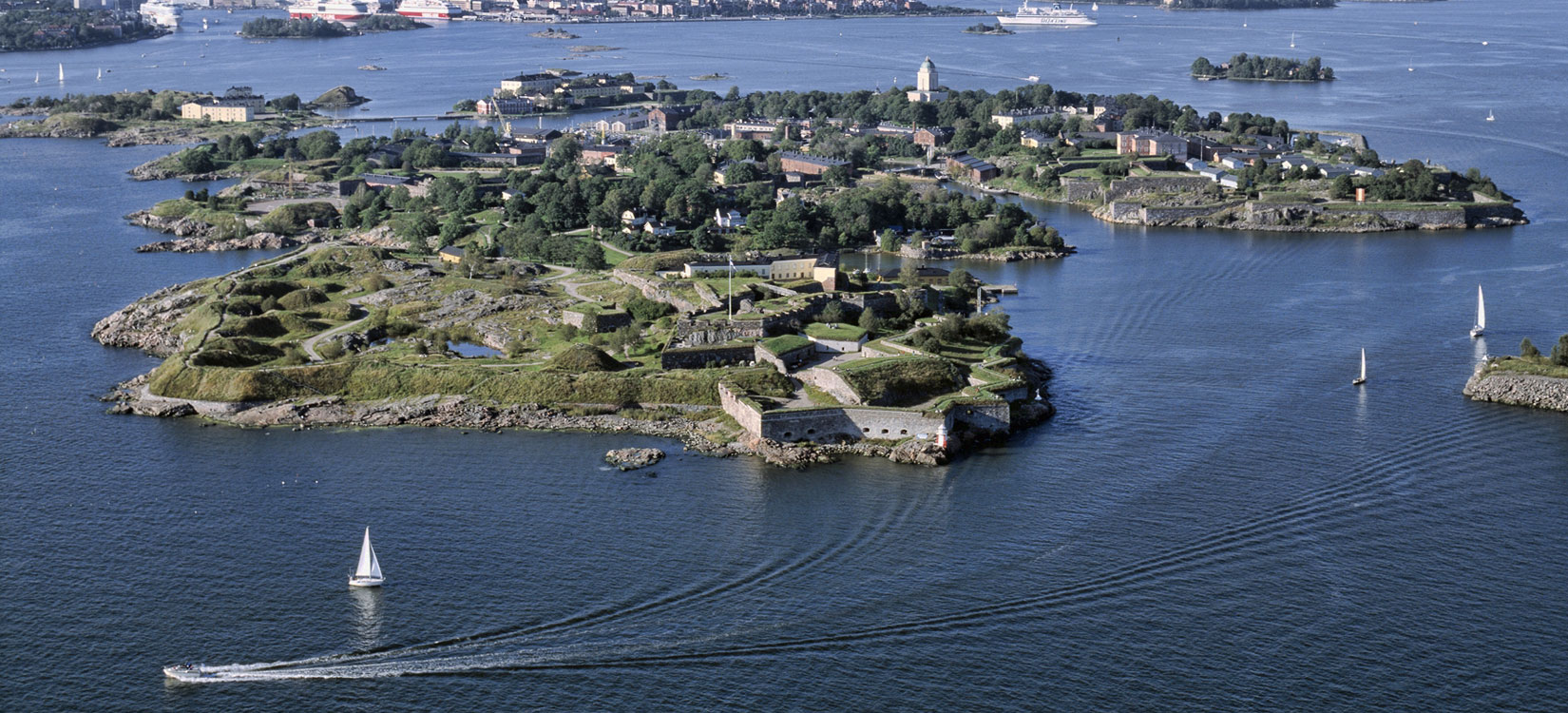
The UNESCO World Heritage and Sustainable Tourism Programme represents a new approach based on dialogue and stakeholder cooperation where planning for tourism and heritage management is integrated at a destination level, the natural and cultural assets are valued and protected, and appropriate tourism developed.
World Heritage and tourism stakeholders share responsibility for conservation of our common cultural and natural heritage of Outstanding Universal Value and for sustainable development through appropriate tourism management.
Facilitate the management and development of sustainable tourism at World Heritage properties through fostering increased awareness, capacity and balanced participation of all stakeholders in order to protect the properties and their Outstanding Universal Value.
Focus Areas
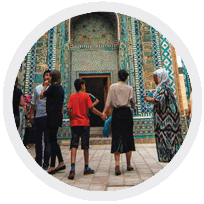
Policy & Strategy
Sustainable tourism policy and strategy development.

Tools & Guidance
Sustainable tourism tools

Capacity Building
Capacity building activities.

Heritage Journeys
Creation of thematic routes to foster heritage based sustainable tourism development
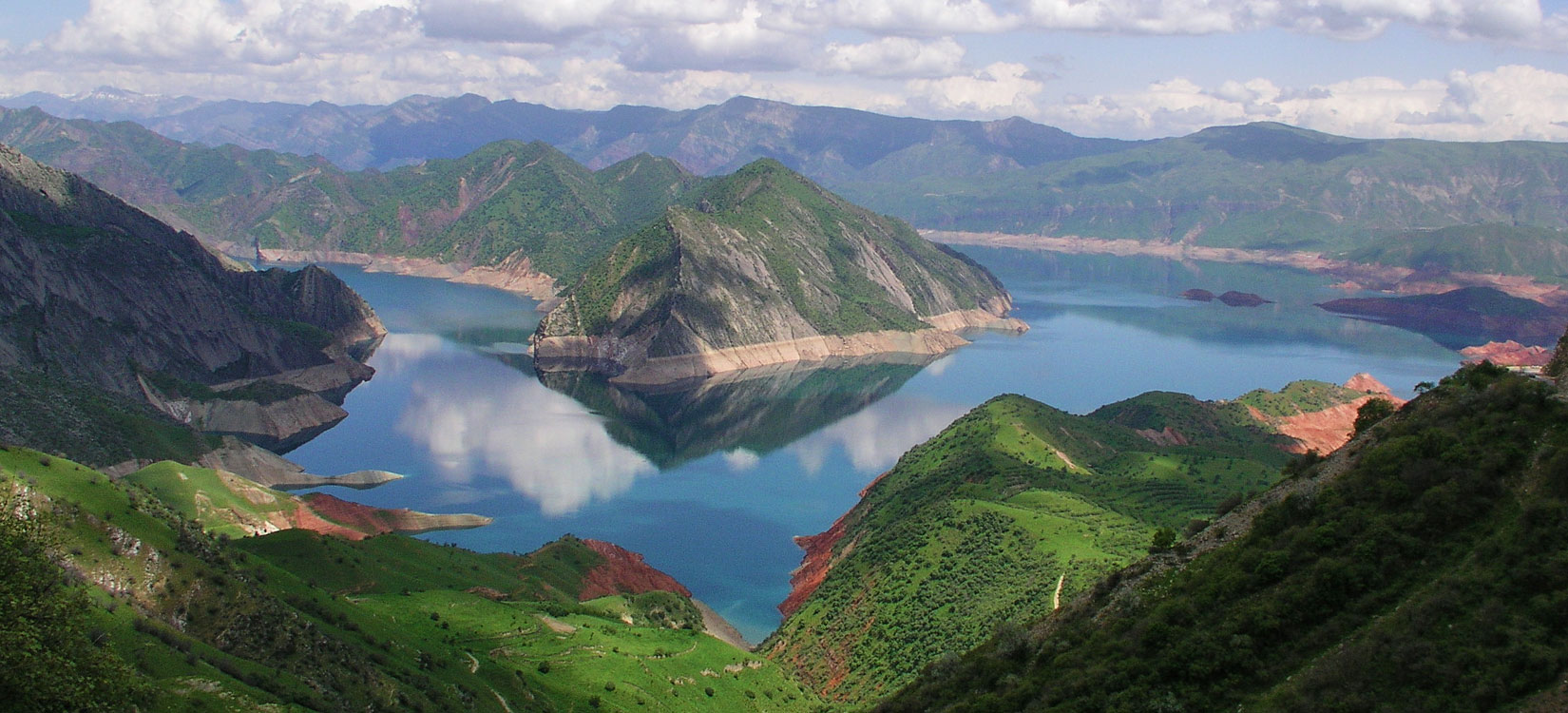
A key goal of the UNESCO WH+ST Programme is to strengthen the enabling environment by advocating policies and frameworks that support sustainable tourism as an important vehicle for managing cultural and natural heritage. Developing strategies through broad stakeholder engagement for the planning, development and management of sustainable tourism that follows a destination approach and focuses on empowering local communities is central to UNESCO’s approach.
Supporting Sustainable Tourism Recovery
Enhancing capacity and resilience in 10 World Heritage communities
Supported by BMZ, and implemented by UNESCO in collaboration with GIZ, this 2 million euro tourism recovery project worked to enhance capacity building in local communities, improve resilience and safeguard heritage.
Policy orientations
Defining the relationship between world heritage and sustainable tourism
Based on the report of the international workshop on Advancing Sustainable Tourism at Natural and Cultural Heritage Sites (Mogao, China, September 2009), the World Heritage Committee at its 34th session adopted the policy orientations which define the relationship between World Heritage and sustainable tourism ( Decision 34 COM 5F.2 ).
World Heritage and Tourism in a Changing Climate
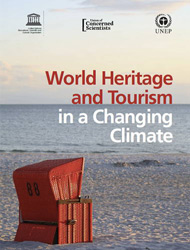
Providing an overview of the increasing vulnerability of World Heritage sites to climate change impacts and the potential implications for and of global tourism.
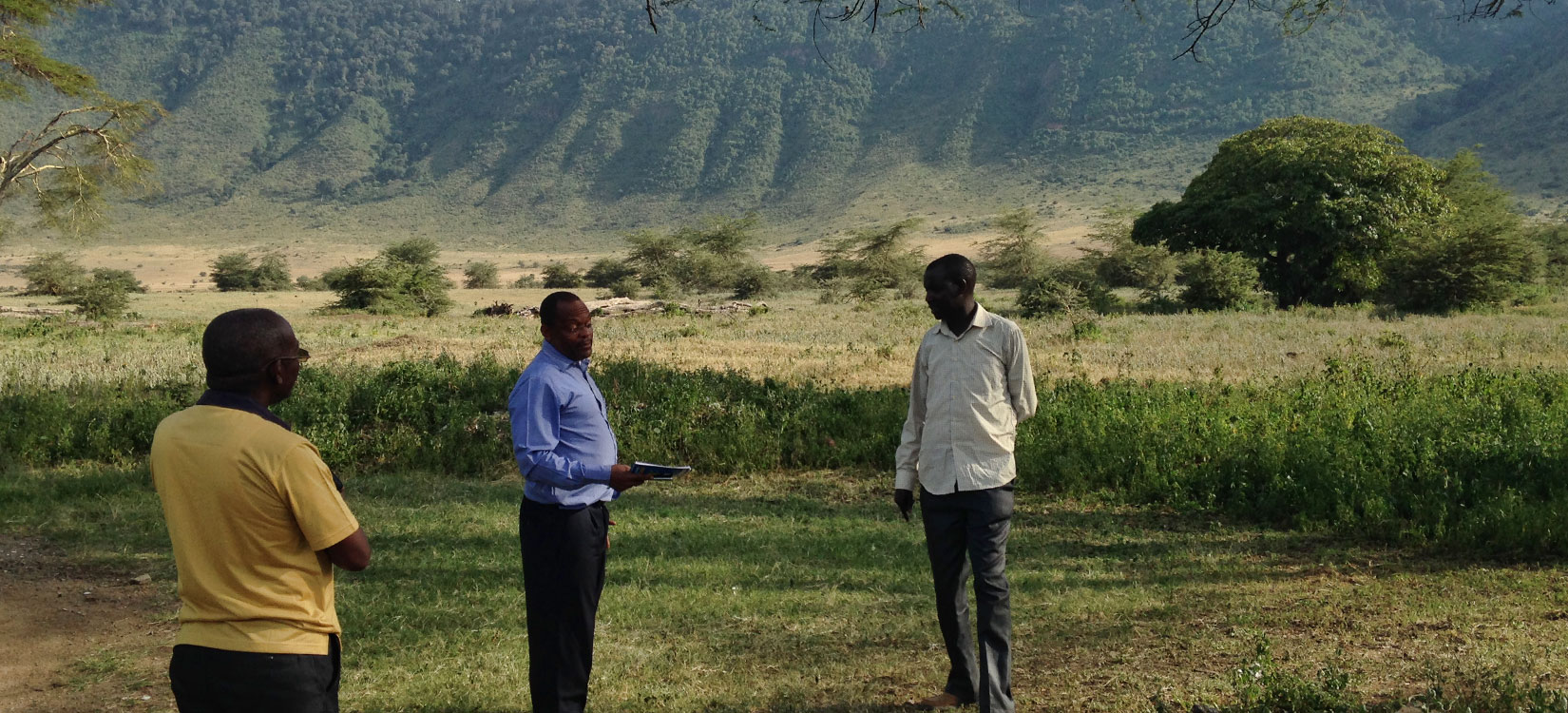
Sustainable Tourism Tools
Manage tourism efficiently, responsibly and sustainably based on the local context and needs
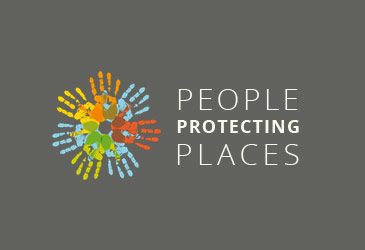
People Protecting Places is the public exchange platform for the World Heritage and Sustainable Tourism Programme, providing education and information, encouraging support, engaging in social and community dialogue

The ' How-To ' guides offer direction and guidance to managers of World Heritage tourism destinations and other stakeholders to help identify the most suitable solutions for circumstances in their local environments and aid in developing general know-how.
English French Russian
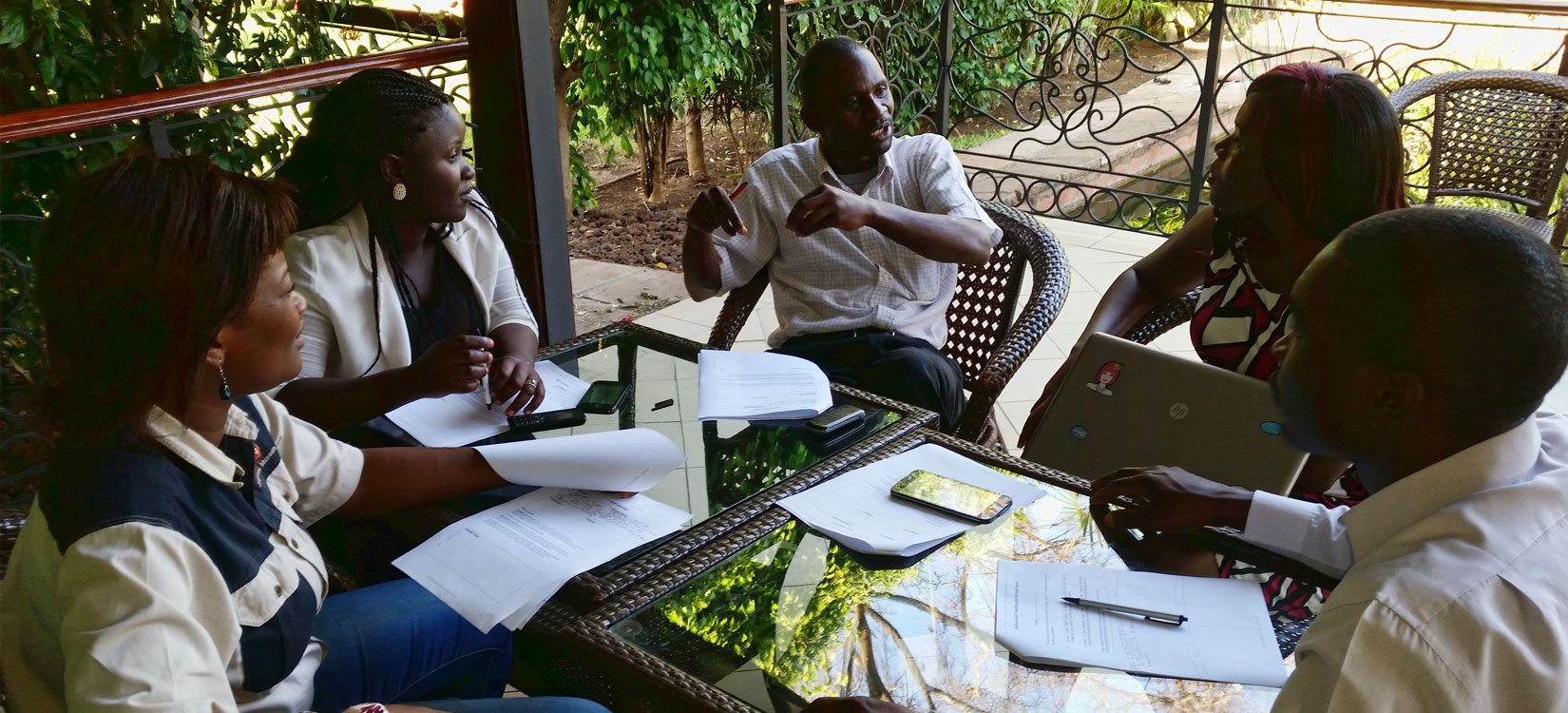
Helping site managers and other tourism stakeholders to manage tourism more sustainably
Capacity Building in 4 Africa Nature Sites
A series of practical training and workshops were organized in four priority natural World Heritage sites in Africa (Lesotho, Malawi, South Africa, Tanzania, Zambia and Zimbabwe) with the aim of providing capacity building tools and strategies for site managers to help them manage tourism at their sites more sustainably.
Learn more →
15 Pilot Sites in Nordic-Baltic Region
The project Towards a Nordic-Baltic pilot region for World Heritage and Sustainable Tourism (2012-2014) was initiated by the Nordic World Heritage Foundation (NWHF). With a practical approach, the project has contributed to tools for assessing and developing sustainable World Heritage tourism strategies with stakeholder involvement and cooperation.
Supporting Community-Based Management and Sustainable Tourism at World Heritage sites in South-East Asia
Entitled “The Power of Culture: Supporting Community-Based Management and Sustainable Tourism at World Heritage sites in South-East Asia", the UNESCO Office in Jakarta with the technical assistance of the UNESCO World Heritage and Sustainable Tourism Programme and the support from the Government of Malaysia is spearheading the first regional effort in Southeast Asia to introduce a new approach to sustainable tourism management at World Heritage sites in Malaysia, the Philippines and Indonesia.
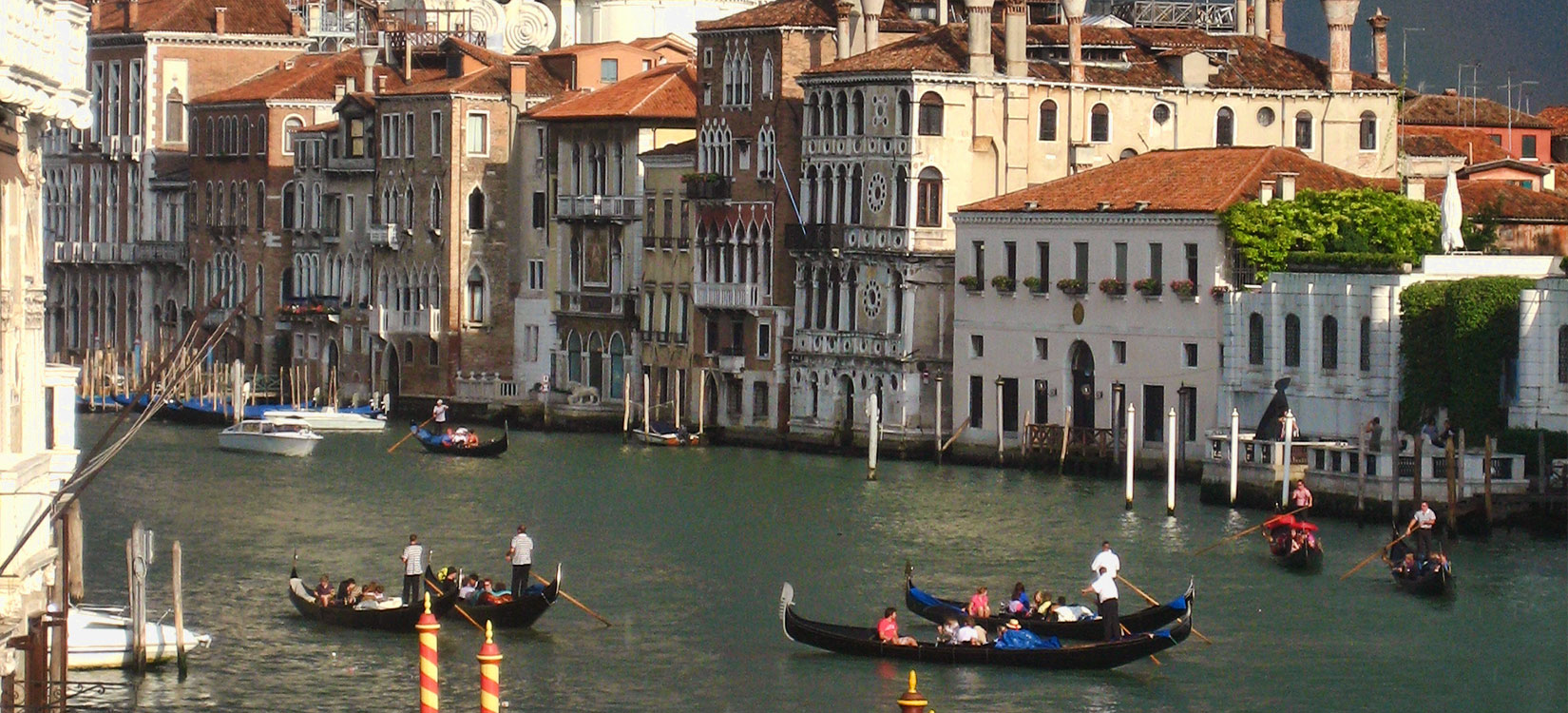
Cultural tourism is one of the largest and fastest-growing global tourism markets. Culture and creative industries are increasingly being used to promote destinations and enhance their competitiveness and attractiveness.
Many locations are now actively developing their cultural assets as a means of developing comparative advantages in an increasingly competitive tourism marketplace, and to create local distinctiveness in the face of globalization.
UNESCO will endeavour to create networks of key stakeholders to coordinate the destination management and marketing associated with the different heritage routes to promote and coordinate high-quality, unique experiences based on UNESCO recognized heritage. The goal is to promote sustainable development based on heritage values and create added tourist value for the sites.
UNESCO World Heritage Journeys of the EU
Creating heritage-based tourism that spurs investment in culture and the creative industries that are community-centered and offer sustainable and high-quality products that play on Europe's comparative advantages and diversity of its cultural assets.
World Heritage Journeys of Buddhist Heritage Sites
UNESCO is currently implementing a project to develop a unique Buddhist Heritage Route for Sustainable Tourism Development in South Asia with the support from the Korea International Cooperation Agency (KOICA). South Asia is host to rich Buddhist heritage that is exemplified in the World Heritage properties across the region.
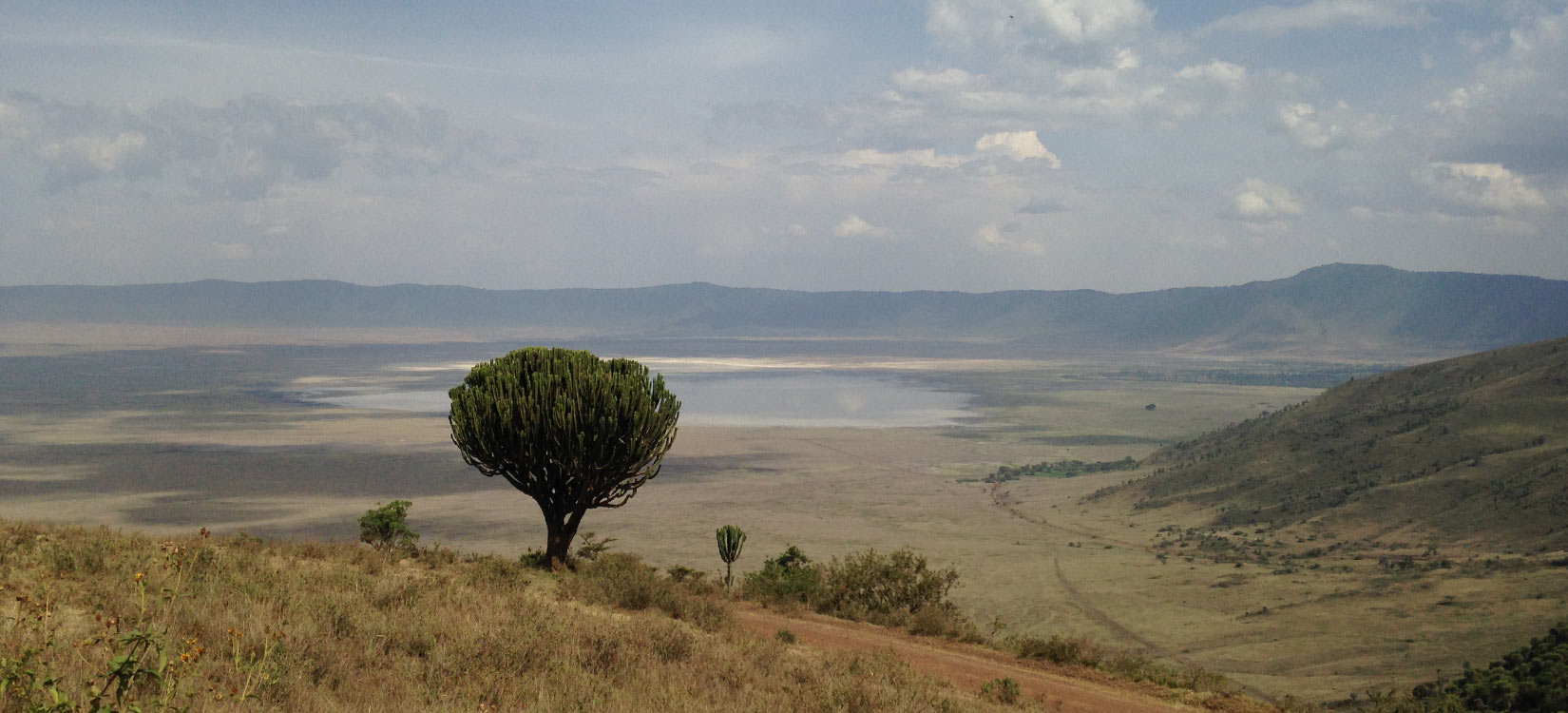
Programme Background
In 2011 UNESCO embarked on developing a new World Heritage and Sustainable Tourism Programme.
The aim was to create an international framework for the cooperative and coordinated achievement of shared and sustainable outcomes related to tourism at World Heritage properties.
The preparatory work undertaken in developing the Programme responded to the decision 34 COM 5F.2 of the World Heritage Committee at its 34th session in Brasilia in 2010, which requested
“the World Heritage Centre to convene a new and inclusive programme on World Heritage and Sustainable Tourism, with a steering group comprising interested States Parties and other relevant stakeholders, and also requests the World Heritage Centre to outline the objectives and approach to the implementation of this programme".
The Steering Group was comprised of States Parties representatives from the six UNESCO Electoral Groups (Germany (I), Slovenia (II), Argentina (III), China (IV), Tanzania (Va), and Lebanon (Vb)), the Director of the World Heritage Centre, the Advisory Bodies (IUCN, ICOMOS and ICCROM), the United Nations World Tourism Organization (UNWTO) and the Swiss Government as the donor agency.
The Government of Switzerland has provided financial support for specific actions to be undertaken by the Steering Group. To coordinate and support the process, the World Heritage Centre has formed a small Working Group with the support of the Nordic World Heritage Foundation, the Government of Switzerland and the mandated external consulting firm MartinJenkins.
The World Heritage Committee directed that the Programme take into account:
- the recommendations of the evaluation of the concluded tourism programme ( WHC-10/34.COM/INF.5F.3 )
- the policy orientation which defines the relationship between World Heritage and sustainable tourism that emerged from the workshop Advancing Sustainable Tourism at Natural and Cultural Heritage Sites (Mogao, China, September 2009) ( WHC-10/34.COM/INF.5F.1 )
Overarching and strategic processes that the new World Heritage and Sustainable Tourism Programme will be aligned with include the Strategic Objectives of the World Heritage Convention (the five C's) ( Budapest Declaration 2002 ), the ongoing Reflections on the Future of the World Heritage Convention ( WHC-11/35.COM/12A ) and the Strategic Action Plan for the Implementation of the World Heritage Convention 2012-2022 ( WHC-11/18.GA/11 ), the Relationship between the World Heritage Convention and Sustainable Development (WHC-10/34.COM/5D), the World Heritage Capacity Building Strategy ( WHC-10/34.COM/5D ), the Global Strategy for a Representative, Balanced and Credible World Heritage List (1994), and the Evaluation of the Global Strategy and PACT initiative ( WHC-11/18.GA/8 - 2011 ).
In addition, the programme development process has been enriched by an outreach to representatives from the main stakeholder groups including the tourism sector, national and local governments, site practitioners and local communities. The programme design was further developed at an Expert Meeting in Sils/Engadine, Switzerland October 2011. In this meeting over 40 experts from 23 countries, representing the relevant stakeholder groups, worked together to identify the overall strategic approach and a prioritised set of key objectives and activities. The proposed Programme was adopted by the World Heritage Committee in 2012 at its 36th session in St Petersburg, Russian Federation .
International Instruments
International Instruments Relating to Sustainable Development and Tourism.
Resolutions adopted by the United Nations, charters adopted by ICOMOS, decisions adopted by the World Heritage Committee, legal instruments adopted by UNESCO on heritage preservation.
Resolutions adopted by the United Nations
- Report by the Department of Economics and Social Affairs: Tourism and Sustainable Development: The Global Importance of Tourism at the United Nations’ Commission on Sustainable Development 7th Session (1999)
- Resolution A/RES/56/212 and the Global Code of Ethics for Tourism adopted by the United Nations World Tourism Organization (1999)
Charters adopted by ICOMOS
- The ICOMOS International Cultural Tourism Charter (1999)
- The ICOMOS Charter for the Interpretation and Presentation of Cultural Heritage Sites (2008)
Decisions adopted by the World Heritage Committee
- Decision (XVII.4-XVII.12) adopted by the World Heritage Committee at its 25th Session in Helsinki (2001)
- Decision 33 COM 5A adopted by the World Heritage Committee at its 30th Session in Seville (2009)
- Decision 34 COM 5F.2 adopted by the World Heritage Committee at its 34th Session in Brasilia (2010)
- Decision 36 COM 5E adopted by the World Heritage Committee at its 36th Session in Saint Petersburg (2012)
Legal instruments adopted by UNESCO on heritage preservation in chronological order
- Convention on the Means of Prohibiting and Preventing the Illicit Import, Export and Transfer of Ownership of Cultural Property (1970)
- The Recommendation for the Protection of Movable Cultural Property (1978)
- The Recommendation on the Safeguarding of Traditional Culture and Folklore (1989)
- The Convention on the Protection of the Underwater Cultural heritage (2001)
- The Convention on the Protection and Promotion of the Diversity of Cultural Expressions (2005)
Other instruments
- Other instruments OECD Tourism Trends and Policies 2012 (French forthcoming)
- Programme on Sustainable Consumption and Production (In English)
- Siem Reap Declaration on Tourism and Culture 2015 – Building a New Partnership Model
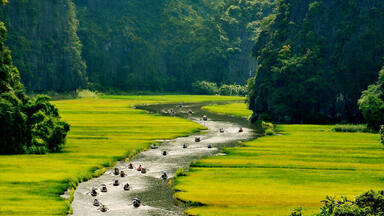
Decisions / Resolutions (5)
The World Heritage Committee,
- Having examined Document WHC/18/42.COM/5A,
- Recalling Decision 41 COM 5A adopted at its 41st session (Krakow, 2017) and Decision 40 COM 5D adopted at its 40th session (Istanbul/UNESCO, 2016), General:
- Takes note with appreciation of the activities undertaken by the World Heritage Centre over the past year in pursuit of the Expected Result to ensure that “tangible heritage is identified, protected, monitored and sustainably managed by Member States, in particular through the effective implementation of the 1972 Convention ”, and the five strategic objectives as presented in Document WHC/18/42.COM/5A;
- Welcomes the proactive role of the Secretariat for enhancing synergies between the World Heritage Convention and the other Culture and Biodiversity-related Conventions, particularly the integration of relevant synergies aspects in the revised Periodic Reporting Format and the launch of a synergy-related web page on the Centre’s website;
- Also welcomes the increased collaboration among the Biodiversity-related Conventions through the Biodiversity Liaison Group and focused activities, including workshops, joint statements and awareness-raising;
- Takes note of the Thematic studies on the recognition of associative values using World Heritage criterion (vi) and on interpretation of sites of memory, funded respectively by Germany and the Republic of Korea and encourages all States Parties to take on board their findings and recommendations, in the framework of the identification of sites, as well as management and interpretation of World Heritage properties;
- Noting the discussion paper by ICOMOS on Evaluations of World Heritage Nominations related to Sites Associated with Memories of Recent Conflicts, decides to convene an Expert Meeting on sites associated with memories of recent conflicts to allow for both philosophical and practical reflections on the nature of memorialization, the value of evolving memories, the inter-relationship between material and immaterial attributes in relation to memory, and the issue of stakeholder consultation; and to develop guidance on whether and how these sites might relate to the purpose and scope of the World Heritage Convention , provided that extra-budgetary funding is available and invites the States Parties to contribute financially to this end;
- Also invites the States Parties to support the activities carried out by the World Heritage Centre for the implementation of the Convention ;
- Requests the World Heritage Centre to present, at its 43rd session, a report on its activities. Thematic Programmes:
- Welcomes the progress report on the implementation of the World Heritage Thematic Programmes and Initiatives, notes their important contribution towards implementation of the Global Strategy for representative World Heritage List, and thanks all States Parties, donors and other organizations for having contributed to achieving their objectives;
- Acknowledges the results achieved by the World Heritage Cities Programme and calls States Parties and other stakeholders to provide human and financial resources ensuring the continuation of this Programme in view of its crucial importance for the conservation of the urban heritage inscribed on the World Heritage List, for the implementation of the Recommendation on the Historic Urban Landscape and its contribution to achieving the 2030 Sustainable Development Goals related to cities as well as for its contribution to the preparation of the New Urban Agenda, and further thanks to China and Croatia for their support for the implementation of the Programme;
- Also acknowledges the results achieved of the World Heritage Marine Programme, also thanks Flanders, France and the Annenberg Foundation for their support, notes the increased focus of the Programme on a global managers network, climate change adaptation strategies and sustainable fisheries, and invites States Parties, the World Heritage Centre and other stakeholders to continue to provide human and financial resources to support for the implementation of the Programme;
- Further acknowledges the results achieved in the implementation of the World Heritage Sustainable Tourism Programme, in particular the development of the Sustainable Tourism and Visitor Management Assessment tool and encourages States Parties to participate in the pilot testing of the tool, expresses appreciation for the funding provided by the European Commission and further thanks the Republic of Korea, Norway, and Seabourn Cruise Line for their support in the implementation of the Programme’’s activities;
- Further notes the progress in the implementation of the Small Island Developing States Programme, its importance for a representative, credible and balanced World Heritage List and building capacity of site managers and stakeholders to implement the World Heritage Convention , thanks furthermore Japan and the Netherlands for their support as well as the International Centre on Space Technology for Natural and Cultural Heritage (HIST) and the World Heritage Institute of Training & Research for the Asia & the Pacific Region (WHITRAP) as Category 2 Centres for their technical and financial supports and also requests the States Parties and other stakeholders to continue to provide human, financial and technical resources for the implementation of the Programme;
- Takes note of the activities implemented jointly by the International Astronomical Union (IAU) and ICOMOS under the institutional guidance of the World Heritage Centre, in line with its Decision 40 COM 5D, further requests the World Heritage Centre to disseminate among the States Parties the second volume of the IAU/ICOMOS Thematic Study on Astronomical Heritage and renames this initiative as Initiative on Heritage of Astronomy, Science and Technology;
- Also takes note of the progress report on the Initiative on Heritage of Religious Interest, endorses the recommendations of the Thematic Expert Consultation meetings focused on Mediterranean and South-Eastern Europe (UNESCO, 2016), Asia-Pacific (Thailand, 2017) and Eastern Europe (Armenia, 2018), thanks the States Parties for their generous contribution and reiterates its invitation to States Parties and other stakeholders to continue to support this Initiative, as well as its associated Marketplace projects developed by the World Heritage Centre;
- Takes note of the activities implemented by CRATerre in the framework of the World Heritage Earthen Architecture Programme, under the overall institutional guidance of the World Heritage Centre, and of the lines of action proposed for the future, if funding is available;
- Invites States Parties, international organizations and donors to contribute financially to the Thematic Programmes and Initiatives as the implementation of thematic priorities is no longer feasible without extra-budgetary funding;
- Requests furthermore the World Heritage Centre to submit an updated result-based report on Thematic Programmes and Initiatives, under Item 5A: Report of the World Heritage Centre on its activities, for examination by the World Heritage Committee at its 44th session in 2020.
1. Having examined document WHC-12/36.COM/5E,
2. Recalling Decision 34 COM 5F.2 adopted at its 34th session (Brasilia, 2010),
3. Welcomes the finalization of the new and inclusive Programme on World Heritage and Sustainable Tourism and notes with appreciation the participatory process for its development, objectives and approach towards implementation;
4. Also welcomes the contribution of the Steering Group comprised of States Parties representatives from the UNESCO Electoral Groups, the World Heritage Centre, the Advisory Bodies (IUCN, ICOMOS, ICCROM), Switzerland and the United Nations World Tourism Organisation (UNWTO) in the elaboration of the Programme;
5. Thanks the Government of Switzerland, the United Nations Foundation and the Nordic World Heritage Foundation for their technical and financial support to the elaboration of the Programme;
6. Notes with appreciation the contribution provided by the States Parties and other consulted stakeholders during the consultation phase of the Programme;
7. Takes note of the results of the Expert Meeting in Sils/Engadin (Switzerland), from 18 to 22 October 2011 contributing to the Programme, and further thanks the Government of Switzerland for hosting the Expert Meeting;
8. Adopts the World Heritage and Sustainable Tourism Programme;
9. Requests the World Heritage Centre to refine the Draft Action Plan 2013-2015 in an Annex to the present document and to implement the Programme with a Steering Group comprised of representatives of the UNESCO Electoral Groups, donor agencies, the Advisory Bodies, UNWTO and in collaboration with interested stakeholders;
10. Notes that financial resources for the coordination and implementation of the Programme do not exist and also requests States Parties to support the implementation of the World Heritage and Sustainable Tourism Programme;
11. Further requests the World Heritage Centre to report biennially on the progress of the implementation of the Programme;
12. Notes with appreciation the launch of the Programme foreseen at the 40th Anniversary of the World Heritage Convention event in Kyoto, Japan, in November 2012
1. Having examined Document WHC-10/34.COM/INF.5F.1 and WHC-10/34.COM/INF.5F.3,
2. Highlighting that the global tourism sector is large and rapidly growing, is diverse and dynamic in its business models and structures, and the relationship between World Heritage and tourism is two way: tourism, if managed well, offers benefits to World Heritage properties and can contribute to cross-cultural exchange but, if not managed well, poses challenges to these properties and recognizing the increasing challenges and opportunities relating to tourism;
3. Expresses its appreciation to the States Parties of Australia, China, France, India, Sweden, Switzerland and the United Kingdom, and to the United Nations Foundation and the Nordic World Heritage Foundation for the financial and technical support to the World Heritage Tourism Programme since its establishment in 2001;
4. Welcomes the report of the international workshop on Advancing Sustainable Tourism at Natural and Cultural Heritage Sites (Mogao, China, September 2009) and adopts the policy orientation which defines the relationship between World Heritage and sustainable tourism ( Attachment A );
5. Takes note of the evaluation of the World Heritage Tourism Programme by the UN Foundation, and encourages the World Heritage Centre to take fully into account the eight programme elements recommended in the draft final report in any future work on tourism ( Attachment B );
6. Decides to conclude the World Heritage Tourism Programme and requests the World Heritage Centre to convene a new and inclusive programme on World Heritage and Sustainable Tourism, with a steering group comprising interested States Parties and other relevant stakeholders, and also requests the World Heritage Centre to outline the objectives and approach to implementation of this programme, drawing on the directions established in the reports identified in Paragraphs 4 and 5 above, for consideration at the 35th session of the World Heritage Committee (2011);
7. Also welcomes the offer of the Government of Switzerland to provide financial and technical support to specific activities supporting the steering group; further welcomes the offer of the Governments of Sweden, Norway and Denmark to organize a Nordic-Baltic regional workshop in Visby, Gotland, Sweden in October 2010 on World Heritage and sustainable tourism; and also encourages States Parties to support the new programme on World Heritage and Sustainable Tourism including through regional events and the publication of materials identifying good practices;
8. Based upon the experience gained under the World Heritage Convention of issues related to tourism, invites the Director General of UNESCO to consider the feasibility of a Recommendation on the relationship between heritage conservation and sustainable tourism.
Attachment A
Recommendations of the international workshop
on Advancing Sustainable Tourism at Natural and Cultural Heritage Sites
Policy orientations: defining the relationship between World Heritage and tourism
1. The tourism sector
The global tourism sector is large and rapidly growing, is diverse and dynamic in its business models and structures.
Tourists/visitors are diverse in terms of cultural background, interests, behaviour, economy, impact, awareness and expectations of World Heritage.
There is no one single way for the World Heritage Convention , or World Heritage properties, to engage with the tourism sector or with tourists/visitors.
2. The relationship between World Heritage and tourism
The relationship between World Heritage and tourism is two-way:
a. World Heritage offers tourists/visitors and the tourism sector destinations
b. Tourism offers World Heritage the ability to meet the requirement in the Convention to 'present' World Heritage properties, and also a means to realise community and economic benefits through sustainable use.
Tourism is critical for World Heritage:
a. For States Parties and their individual properties,
i. to meet the requirement in the Convention to 'present' World Heritage
ii. to realise community and economic benefits
b. For the World Heritage Convention as a whole, as the means by which World Heritage properties are experienced by visitors travelling nationally and internationally
c. As a major means by which the performance of World Heritage properties, and therefore the standing of the Convention , is judged,
i. many World Heritage properties do not identify themselves as such, or do not adequately present their Outstanding Universal Value
ii. it would be beneficial to develop indicators of the quality of presentation, and the representation of the World Heritage brand
d. As a credibility issue in relation to: i. the potential for tourism infrastructure to damage Outstanding Universal Value
i. the threat that World Heritage properties may be unsustainably managed in relation to their adjoining communities
ii. sustaining the conservation objectives of the Convention whilst engaging with economic development
iii. realistic aspirations that World Heritage can attract tourism.
World Heritage is a major resource for the tourism sector:
a. Almost all individual World Heritage properties are significant tourism destinations
b. The World Heritage brand can attract tourists/visitors,
i. the World Heritage brand has more impact upon tourism to lesser known properties than to iconic properties.
Tourism, if managed well, offers benefits to World Heritage properties:
a. to meet the requirement in Article 4 of the Convention to present World Heritage to current and future generations
b. to realise economic benefits.
Tourism, if not managed well, poses threats to World Heritage properties.
3. The responses of World Heritage to tourism
The impact of tourism, and the management response, is different for each World Heritage property: World Heritage properties have many options to manage the impacts of tourism.
The management responses of World Heritage properties need to:
a. work closely with the tourism sector
b. be informed by the experiences of tourists/visitors to the visitation of the property
c. include local communities in the planning and management of all aspects of properties, including tourism.
While there are many excellent examples of World Heritage properties successfully managing their relationship to tourism, it is also clear that many properties could improve:
a. the prevention and management of tourism threats and impacts
b. their relationship to the tourism sector inside and outside the property
c. their interaction with local communities inside and outside the property
d. their presentation of Outstanding Universal Value and focus upon the experience of tourists/visitors.
a. be based on the protection and conservation of the Outstanding Universal Value of the property, and its effective and authentic presentation
b. work closely with the tourism sector
c. be informed by the experiences of tourists/visitors to the visitation of the property
d. to include local communities in the planning and management of all aspects of properties, including tourism.
4. Responsibilities of different actors in relation to World Heritage and tourism
The World Heritage Convention (World Heritage Committee, World Heritage Centre, Advisory Bodies):
a. set frameworks and policy approaches
b. confirm that properties have adequate mechanisms to address tourism before they are inscribed on the World Heritage List
i. develop guidance on the expectations to be include in management plans
c. monitor the impact upon OUV of tourism activities at inscribed sites, including through indicators for state of conservation reporting
d. cooperate with other international organisations to enable:
i. other international organisations to integrate World Heritage considerations in their programs
ii. all parties involved in World Heritage to learn from the activities of other international organisations
e. assist State Parties and sites to access support and advice on good practices
f. reward best practice examples of World Heritage properties and businesses within the tourist/visitor sector
g. develop guidance on the use of the World Heritage emblem as part of site branding.
Individual States Parties:
a. develop national policies for protection
b. develop national policies for promotion
c. engage with their sites to provide and enable support, and to ensure that the promotion and the tourism objectives respect Outstanding Universal Value and are appropriate and sustainable
d. ensure that individual World Heritage properties within their territory do not have their OUV negatively affected by tourism.
Individual property managers:
a. manage the impact of tourism upon the OUV of properties
i. common tools at properties include fees, charges, schedules of opening and restrictions on access
b. lead onsite presentation and provide meaningful visitor experiences
c. work with the tourist/visitor sector, and be aware of the needs and experiences of tourists/visitors, to best protect the property
i. the best point of engagement between the World Heritage Convention and the tourism sector as a whole is at the direct site level, or within countries
d. engage with communities and business on conservation and development.
Tourism sector:
a. work with World Heritage property managers to help protect Outstanding Universal Value
b. recognize and engage in shared responsibility to sustain World Heritage properties as tourism resources
c. work on authentic presentation and quality experiences.
Individual tourists/visitors with the assistance of World Heritage property managers and the tourism sector, can be helped to appreciate and protect the OUV of World Heritage properties.
Attachment B
Programme elements recommended by the Draft Final Report of the Evaluation of the World Heritage Tourism Programme by the UN Foundation:
1. Adopt and disseminate standards and principles relating to sustainable tourism at World Heritage sites;
2. Support the incorporation of appropriate tourism management into the workings of the Convention ;
3. Collation of evidence to support sustainable tourism programme design, and to support targeting;
4. Contribution of a World Heritage perspective to cross agency sustainable tourism policy initiatives;
5. Strategic support for the dissemination of lessons learned;
6. Strategic support for the development of training and guidance materials for national policy agencies and site managers;
7. Provision of advice on the cost benefit impact of World Heritage inscription;
8. Provision of advice on UNESCO World Heritage branding.
1. Having examined Documents WHC-09/33.COM/5A, WHC- 09/33.COM/INF.5A.1, WHC-09/33.COM/INF.5A.2, and WHC-09/33.COM/INF.5A.3 ,
2. Recalling Decision 32 COM 5 adopted at its 32nd session (Quebec City, 2008),
3. Takes note with appreciation of the activities undertaken by the World Heritage Centre over the past year in pursuit of the Committee's five Strategic Objectives;
4. Takes also note of the findings of the study undertaken by UNESCO's Internal Oversight Service on the mapping of the workload of the World Heritage Centre presented in Document WHC-09/33.COM/INF.5A.3;
5. Notes with satisfaction that the World Heritage Centre is working with the secretariats of intergovernmental committees of related conventions such as the Convention for the Safeguarding of Intangible Cultural Heritage , and the Convention for the Protection of the Underwater Cultural Heritage-2001 and recommends that such cooperation be encouraged as this would further strengthen the work of the Centre;
6. Requests the World Heritage Centre to prepare a document on the World Heritage Convention and its cooperation and exchange with other conventions and programmes in the field of cultural heritage for discussion at the 34th session of the World Heritage Committee (2010);
7. Also requests the World Heritage Centre, in future reports on activities undertaken, to further strengthen the information and analysis available to States Parties by:
a) Retaining the current format to report activities and including an update on progress with implementing the Committee's decisions,
b) Describing the criteria by which the World Heritage Centre makes decisions as to which activities under the Convention it undertakes,
c) And including, on a discretionary basis, analysis of strategic issues and new directions;
8. Further requests the World Heritage Centre to produce, on an experimental basis, an indexed audio verbatim recording of the proceedings of the 33rd Session in addition to the standard summary records (as produced since the 26th session of the World Heritage Committee);
9. Notes the outline provided by the World Heritage Centre of its roles and the roles of the Advisory Bodies and agrees that this topic be further discussed at the 34th session of the Committee in 2010 under a separate agenda item;
10. Requests furthermore the World Heritage Centre to outline the forward direction of the World Heritage thematic programmes and initiatives, to enable an understanding of how these themes connect with and integrate into general programmes, and how they might be resourced;
11. Notes that the Centre already proactively engages women in its Heritage Programmes in Asia, Africa and the Caribbean as part of its gender balance policy and the provision of equal opportunity to all, and recommends that gender balance and community involvement be prioritized in the Centre's programmes;
12. Adopts the World Heritage Thematic Programme on Prehistory presented in Annex 1 of document WHC-09/33.COM/5A ;
13. Requests the World Heritage Centre to reconsider the term "prehistory", to better recognize the continuing cultures of indigenous communities, to ensure global representation in the identification and conservation of related properties, and to present a report on progress in developing an Action Plan on Prehistory and World Heritage at its 34th session in 2010;
14. Notes with concern the ongoing destruction of some of these fragile sites, including the recent destruction of the Rock Art sites of Tardrat Acacus in Libya, and requests the State Party to take immediate action and other measures as necessary to address the problem in consultation with the World Heritage Centre and to invite a joint World Heritage Centre / ICOMOS mission;
15. Expresses its gratitude to the Governments of Bahrain, South Africa and Spain for the financial and technical support for the various international scientific encounters, and recognizes the proposal of the Government of Spain in establishing a centre for the research of Prehistory;
16. Recalling the Decision of the World Heritage Committee 31 COM.21C to carry out a programme of sustainable development concerning the conservation of earthen architecture, thanks the Governments of Italy and France for their support of the programme on earthen architecture in Africa and the Arab States in particular, and requests the potential financial donors and the States Parties to support the implementation of activities and further requests the World Heritage Centre to submit a progress report at its 35th session in 2011;
17. Takes note of the progress report on the World Heritage Tourism Programme;
18. Thanks the Governments of Australia, China, France, India, Switzerland and United Kingdom, who have worked in close collaboration with the World Heritage Centre and the Advisory Bodies, the World Tourism Organization and other partners, for contributing to the Initiative of Sustainable Tourism;
19. Expresses its gratitude to the Governments of Australia and China for the organization of a workshop on sustainable tourism at the World Heritage site, Mogao Caves, China, in September-October 2009 and requests that the following elements be submitted to the Committee for examination at its 34th session in 2010:
a) A report on the workshop,
b) The subsequent recommendations of the workshop regarding the adoption of best practices policy guidance, and concerning the changes proposed for the Operational Guidelines for the implementation of the World Heritage Convention ,
c) A document concerning the progress of the World Heritage Programme on Tourism;
20. Finally requests the Director of the World Heritage Centre to identify supplementary sources of funding to put into place a sufficient number of staff and resources at the World Heritage Centre and the Advisory Bodies in order to continue to efficiently contribute to the resolution of problems related to World Heritage conservation.
XVII.8 The Secretariat provided the following justifications for the selection:
- Tourism - growing threats on World Heritage sites from tourism which, if sustainably managed could offer socio-economic development opportunities;
- Forests - since close to 60 of the natural sites on the World Heritage List are forests and that the lessons being learned from the large-scale UNESCO-UN Foundation projects in the tropical forest sites in the Democratic Republic of the Congo can serve as case studies to enrich the programme;
- Cities - since close to 200 of the cultural sites on the List are historic centres or entire cities, and because 20% of the Fund's international assistance have served to address the challenge of urban heritage conservation;
- Earthen structures - since some 30 of the cultural sites on the List are included in this category, and due to the particularity of conservation of earthen heritage, and threats.
XVII.10 The Committee expressed its appreciation for the clarity of the presentation and the justifications provided. Indicating strong support for the overall programming approach, the Committee however indicated the need for the programme to respond to the priorities established by the Committee and to create strong links with the results of the Global Strategy actions and Periodic Reporting. The Committee approved the four proposed themes of the programmes in this first series of initiatives and authorized the Centre to proceed in their development.
Click through the PLOS taxonomy to find articles in your field.
For more information about PLOS Subject Areas, click here .
Loading metrics
Open Access
Peer-reviewed
Research Article
Exploring the relationships between heritage tourism, sustainable community development and host communities’ health and wellbeing: A systematic review
Roles Data curation, Formal analysis, Investigation, Methodology, Project administration, Writing – original draft, Writing – review & editing
Affiliation Translational Health Research Institute, School of Medicine, Western Sydney University, Sydney, Australia
Roles Conceptualization, Formal analysis, Writing – original draft, Writing – review & editing
Affiliations School of Social Sciences, Western Sydney University, Sydney, Australia, Department of Archaeology, University of York, York, United Kingdom
* E-mail: [email protected]
Roles Conceptualization, Data curation, Formal analysis, Methodology, Supervision, Writing – original draft, Writing – review & editing
Affiliations Translational Health Research Institute, School of Medicine, Western Sydney University, Sydney, Australia, Maternal, Child and Adolescent Health Program, Burnet Institute, Melbourne, Australia
- Cristy Brooks,
- Emma Waterton,
- Hayley Saul,
- Andre Renzaho

- Published: March 29, 2023
- https://doi.org/10.1371/journal.pone.0282319
- Reader Comments
Previous studies examining the impact of heritage tourism have focused on specific ecological, economic, political, or cultural impacts. Research focused on the extent to which heritage tourism fosters host communities’ participation and enhances their capacity to flourish and support long-term health and wellbeing is lacking. This systematic review assessed the impact of heritage tourism on sustainable community development, as well as the health and wellbeing of local communities. Studies were included if they: (i) were conducted in English; (ii) were published between January 2000 and March 2021; (iii) used qualitative and/or quantitative methods; (iv) analysed the impact of heritage tourism on sustainable community development and/or the health and wellbeing of local host communities; and (v) had a full-text copy available. The search identified 5292 articles, of which 102 articles met the inclusion criteria. The included studies covering six WHO regions (Western Pacific, African, Americas, South-East Asia, European, Eastern Mediterranean, and multiple regions). These studies show that heritage tourism had positive and negative impacts on social determinants of health. Positive impacts included economic gains, rejuvenation of culture, infrastructure development, and improved social services. However, heritage tourism also had deleterious effects on health, such as restrictions placed on local community participation and access to land, loss of livelihood, relocation and/or fragmentation of communities, increased outmigration, increases in crime, and erosion of culture. Thus, while heritage tourism may be a poverty-reducing strategy, its success depends on the inclusion of host communities in heritage tourism governance, decision-making processes, and access to resources and programs. Future policymakers are encouraged to adopt a holistic view of benefits along with detriments to sustainable heritage tourism development. Additional research should consider the health and wellbeing of local community groups engaged in heritage tourism. Protocol PROSPERO registration number: CRD42018114681.
Citation: Brooks C, Waterton E, Saul H, Renzaho A (2023) Exploring the relationships between heritage tourism, sustainable community development and host communities’ health and wellbeing: A systematic review. PLoS ONE 18(3): e0282319. https://doi.org/10.1371/journal.pone.0282319
Editor: Tai Ming Wut, The Hong Kong Polytechnic University, HONG KONG
Received: April 29, 2022; Accepted: February 14, 2023; Published: March 29, 2023
Copyright: © 2023 Brooks et al. This is an open access article distributed under the terms of the Creative Commons Attribution License , which permits unrestricted use, distribution, and reproduction in any medium, provided the original author and source are credited.
Data Availability: All relevant data are within the paper.
Funding: The author(s) received no specific funding for this work.
Competing interests: The authors have declared that no competing interests exist.
Introduction
Tourism, heritage, and sustainable development go hand in hand. Socio-economically, tourism is considered a vital means of sustainable human development worldwide, and remains one of the world’s top creators of employment and a lead income-generator, particularly for Global South countries [ 1 ]. For most low- and middle-income countries (LMICs), tourism is a key component of export earnings and export diversification, and a major source of foreign-currency income [ 1 ]. In 2019, prior to the international travel restrictions implemented to contain the spread of coronavirus disease (COVID-19), export revenues from international tourism were estimated at USD 1.7 trillion, the world’s third largest export category after fuels and chemicals with great economic impacts. Tourism remains a major part of gross domestic product, generating millions of direct and indirect jobs, and helping LMICs reduce trade deficits [ 1 ]. It accounts for 28 per cent of the world’s trade in services, 7 per cent of overall exports of goods and services and 1 out of 10 jobs in the world [ 1 ]. Given this, it is anticipated that tourism will play a strong role in achieving all of the Sustainable Development Goals (SDGs), but particularly Goals 1 (No poverty), 8 (Decent work and economic growth), 12 (Responsible consumption and production), 13 (Climate action) and 14 (Life below water).
To ensure tourism’s continued contribution to sustainable development efforts, the World Tourism Organisation (UNWTO) has established the T4SDG platform in order to “to make tourism matter on the journey to 2030” [ 2 ]. Likewise, in recognition of the relationship between heritage, tourism, and sustainable development, UNESCO launched the World Heritage and Sustainable Tourism Programme, which was adopted by the World Heritage Committee in 2012. This Programme encapsulates a framework that builds on dialogue and stakeholder cooperation to promote an integrated approach to planning for tourism and heritage management in host countries, to protect and value natural and cultural assets, and develop appropriate and sustainable tourism pathways [ 3 ].
The addition of ‘heritage’ creates an important sub-category within the tourism industry: heritage tourism. This study adopts a broad definition of ‘heritage’, which encompasses the intersecting forms of tangible heritage, such as buildings, monuments, and works of art, intangible or living heritage, including folklore, cultural memories, celebrations and traditions, and natural heritage, or culturally infused landscapes and places of significant biodiversity [ 4 ]. This encompassing definition captures ‘heritage’ as it is understood at the international level, as evidenced by two key UNESCO conventions: the 1972 Convention Concerning the Protection of the World Cultural and Natural Heritage , which protects cultural, natural, and mixed heritage; and the 2003 Convention for the Safeguarding of the Intangible Cultural Heritage , which protects intangible heritage. Although the identification, conservation and management of heritage has traditionally been driven by national aspirations to preserve connections with history, ancestry, and national identity, the social and economic benefits of heritage tourism at community levels have also been documented [ 5 ].
Heritage tourism, as one of the oldest practices of travelling for leisure, is a significant sector of the tourism industry. It refers to the practice of visiting places because of their connections to cultural, natural, and intangible heritage and is oriented towards showcasing notable relationships to a shared past at a given tourism destination [ 4 ]. It contributes to global interchange and inter-cultural understanding [ 4 ]. Heritage tourism places economic and political value on recognised heritage resources and assets, providing additional reasons to conserve heritage further to the cultural imperatives for its maintenance [ 5 ]. By drawing on the cultural and historical capital of a community, heritage tourism can contribute to the flourishing of local communities and their positive sustainable development. However, as this systematic review will demonstrate, when applied uncritically and without meaningful engagement with the needs of local stakeholder, heritage tourism can also elicit damaging effects on community health and wellbeing.
First published in 1987, the classic report ‘ Our Common Future’ , more commonly known as the Brundtland Report, conceptualised sustainable development as “development that meets the needs of the present without compromising the ability of future generations to meet their own needs” [ 6 ]. Although this definition still works for many purposes, it emphasised the critical issues of environment and development whilst turning on the undefined implications of the word ‘needs’. In the report, the concept of sustainable development thus left unspecified the assumed importance of distinct cultural, political, economic, and ecological needs as well as health needs. Drawing on the work of globalization and cultural diversity scholar, Paul James [ 7 ], in this study we have defined ‘positive sustainable development’ as those “practices and meanings of human engagement that make for lifeworlds that project the ongoing probability of natural and social flourishing”, taking into account questions of vitality, relationality, productivity and sustainability.
Study rationale
For many years, the impact of heritage tourism has predominantly been viewed through ecological [ 8 , 9 ], economic and cultural [ 10 , 11 ] or political [ 12 ] lenses. For example, it has often been assumed that the conservation of historic, cultural, and natural resources, in combination with tourism, will naturally lead to sustainable local economies through increases in employment opportunities, provisioning of a platform for profitable new business opportunities, investment in infrastructure, improving public utilities and transport infrastructures, supporting the protection of natural resources, and, more recently, improving quality of life for local residents [ 13 – 15 ].
Similarly, the impact of heritage tourism on health and wellbeing has tended to focus on visitors’ wellbeing, including their health education and possible health trends, medical aspects of travel preparation, and health problems in returning tourists [ 16 – 18 ]. It has only been more recently that host communities’ health needs and wellbeing have been recognised as an intrinsic part of cultural heritage management and sustainable community development [ 19 ]. In this literature, it has been hypothesised that potential health implications of heritage tourism are either indirect or direct. Indirect effects are predominantly associated with health gains from heritage tourism-related economic, environmental, socio-cultural, and political impacts [ 20 ]. In contrast, health implications associated with direct impacts are closely associated with immediate encounters between tourism and people [ 20 ]. Yet, little is known of the overall generative effects of heritage tourism on sustainable community development, or the long-term health and wellbeing of local communities. For the first time, this systematic review identified and evaluated 102 published and unpublished studies in order to assess the extent to which heritage tourism fosters host communities’ participation and, consequently, their capacity to flourish, with emphasis placed on the long-term health impacts of this. The primary objective of the review was to determine: (1) what the impacts of heritage tourism are on sustainable community development; as well as (2) on the health and wellbeing of local host communities. Understanding the relationship between heritage tourism, sustainable community development and health is essential in influencing policies aimed at improving overall livelihood in local host communities, as well as informing intervention strategies and knowledge advancement.
This systematic review adhered to the guidelines and criteria set out in the Preferred Reporting Items for Systematic Reviews and Meta-Analyses (PRISMA) 2020 statement [ 21 ]. A protocol for this review was registered with PROSPERO (CRD42018114681) and has been published [ 22 ].
Search strategy
In order to avoid replicating an already existing study on this topic, Cochrane library, Google Scholar and Scopus were searched to ensure there were no previous systematic reviews or meta-analyses on the impact of heritage tourism on sustainable community development and the health of local host communities. No such reviews or analyses were found. The search then sought to use a list of relevant text words and sub-headings of keywords and/or MeSH vocabulary according to each searched database. Derived from the above research question, the key search words were related to heritage tourism, sustainable community development, and health and wellbeing of local host communities. A trial search of our selected databases (see below) found that there are no MeSH words for heritage and tourism. Therefore, multiple keywords were included to identify relevant articles.
To obtain more focused and productive results, the keywords were linked using “AND” and “OR” and other relevant Boolean operators, where permitted by the databases. Subject heading truncations (*) were applied where appropriate. The search query was developed and tested in ProQuest Central on 22 November 2018. Following this search trial, the following combination of search terms and keywords, slightly modified to suit each database, was subsequently used:
(“Heritage tourism” OR tourism OR “world heritage site” OR ecotourism OR “heritage based tourism” OR “cultural tourism” OR “diaspora tourism” OR “cultural heritage tourism” OR “cultural resource management” OR “cultural heritage management” OR “historic site”)
(“Health status” [MeSH] OR “health equity” OR health OR community health OR welfare OR wellbeing)
(“sustainable development” [MeSH] OR sustainab* or “community development” or “local development” or “local community” or “indigenous community”)
The search covered the following bibliographic databases and electronic collections:
- Academic Search Complete
- Australian Heritage Bibliography (AHB)
- Applied Social Sciences Index and Abstracts (ASSIA)
- CAB Abstracts
- ProQuest Central
- Science And Geography Education (SAGE)
- Tourism, Hospitality and Leisure
In addition, grey literature were also sourced from key organisation websites including the International Union for Conservation of Nature (IUCN), the International Council on Monuments and Sites (ICOMOS), the International Centre for the Study of the Preservation and Restoration of Cultural Property (ICCROM), the International Centre for Integrated Mountain Development (ICIMOD), the International Council of Museums (ICOM), the United Nations Educational Scientific and Cultural Organization (UNESCO), the United Nations World Tourism Organisation (UNWTO) and the Smithsonian Institution.
Where the full texts of included articles could not be accessed, corresponding authors were contacted via e-mail or other means of communication (e.g., ResearchGate) to obtain a copy. A further search of the bibliographical references of all retrieved articles and articles’ citation tracking using Google Scholar was conducted to capture relevant articles that might have been missed during the initial search but that meet the inclusion criteria. For the purposes of transparency and accountability, a search log was kept and constantly updated to ensure that newly published articles were captured. To maximise the accuracy of the search, two researchers with extensive knowledge of heritage tourism literature (EW and HS) and two research assistants with backgrounds in public health and social sciences implemented independently the search syntax across the databases and organisations’ websites to ensure no article was missed.
Inclusion and exclusion criteria
Criteria used in this systematic review focused on the types of beneficiaries of heritage tourism, outcomes of interest, as well as the intervention designs. The outcomes of interest were sustainable community development and evidence for the overall health and wellbeing of local host communities. In this systematic review, sustainable community development was defined in terms of its two components: ‘community sustainability’ and ‘development’. Community sustainability was conceptualised as the “long-term durability of a community as it negotiates changing practices and meanings across all the domains of culture, politics, economics and ecology” (pp. 21, 24) [ 23 ].
In contrast, development was conceptualised as “social change—with all its intended or unintended outcomes, good and bad—that brings about a significant and patterned shift in the technologies, techniques, infrastructure, and/or associated life-forms of a place or people” (p. 44) [ 7 ]. To this, we added the question of whether the development was positive or negative. Thus, going beyond the Brundtland definition introduced earlier and once again borrowing from the work of Paul James, positive sustainable development was defined as “practices and meanings of human engagement that make for lifeworlds that project the ongoing probability of natural and social flourishing”, including good health [ 23 ].
Health was defined, using the World Health Organisation (WHO) definition, as “overall well-being” and as including both physical, mental and social health [ 24 ]. While there is no consensus on what wellbeing actually means, there is a general agreement that wellbeing encompasses positive emotions and moods (e.g., contentment, happiness), the absence of negative emotions (e.g., depression, anxiety) as well as satisfaction with life and positive functioning [ 25 ]. Therefore, wellbeing in this systematic review was conceptualised according to Ryff’s multidimensional model of psychological wellbeing, which includes six factors: autonomy; self-acceptance, environmental mastery, positive relationships with others, purpose in life, and personal growth [ 26 ].
In terms of intervention and design, this systematic review included peer-reviewed and grey literature sources of evidence [ 27 , 28 ] from quantitative, qualitative, and mixed methods studies. Intervention designs of interest were observational studies (e.g. longitudinal studies, case control and cross-sectional studies) as well as qualitative and mixed-methods studies. The following additional restrictions were used to ensure texts were included only if they were: (i) written in English; (ii) analysed the impact of heritage tourism on sustainable community development and health and/or wellbeing of local host communities; (iii) research papers, dissertations, books, book chapters, working papers, technical reports including project documents and evaluation reports, discussion papers, and conference papers; and (iv) published between January 2000 and March 2021. Studies were excluded if they were descriptive in nature and did not have community development or health and wellbeing indicators as outcome measures.
The year 2000 was selected as the baseline date due to the signing of the United Nations Millennium Development Goals (MDGs) by Member States in September of that year. With the introduction of the MDGs, now superseded by the Sustainable Development Goals (SDGs), there was an increase in commitment from government and non-governmental organizations to promote the development of responsible, sustainable and universally accessible tourism [ 29 , 30 ]. Editorials, reviews, letter to editors, commentaries and opinion pieces were not considered. Where full text articles were not able to be retrieved despite exhausting all available methods (including contacting corresponding author/s), such studies were excluded from the review. Non-human studies were also excluded.
Study selection and screening
Data retrieved from the various database searches were imported into an EndNote X9 library. A three-stage screening process was followed to assess each study’s eligibility for inclusion. In the EndNote library, stage one involved screening studies by titles to remove duplicates. In stage two, titles and abstracts were manually screened for eligibility and relevance. In the third and final screening stage, full texts of selected abstracts were further reviewed for eligibility. The full study selection process according to PRISMA is summarised in Fig 1 . A total of 5292 articles from 10 databases and multiple sources of grey literature were screened. After removal of duplicates, 4293 articles were retained.
- PPT PowerPoint slide
- PNG larger image
- TIFF original image
https://doi.org/10.1371/journal.pone.0282319.g001
Titles and abstracts were further screened for indications that articles contain empirical research on the relationship between heritage tourism, sustainable community development and the health and wellbeing of local host communities. This element of the screening process resulted in the exclusion of 2892 articles. The remaining 1401 articles were screened for eligibility: 1299 articles were further excluded, resulting in 102 articles that met our inclusion criteria and were retained for analysis. Study selection was led by two researchers (EW and HS) and one research assistant, who independently double-checked 40% of randomly selected articles (n = 53). Interrater agreement was calculated using a 3-point ordinal scale, with the scoring being ’yes, definitely in’ = 1, ’?’ for unsure = 2, and ’no, definitely out’ = 3. Weighted Kappa coefficients were calculated using quadratic weights. Kappa statistics and percentage of agreement were 0.76 (95%CI: 0.63, 0.90) and 0.90 (95%CI: 0.85, 0.96) respectively, suggesting excellent agreement.
Data extraction
Data extraction was completed using a piloted form and was performed and subsequently reviewed independently by three researchers (AR, EW and HS), all of whom are authors. The extracted data included: study details (author, year of publication, country of research), study aims and objectives, study characteristics and methodological approach (study design, sample size, outcome measures, intervention), major findings, and limitations.
Quality assessment
To account for the diversity in design and dissemination strategies (peer-reviewed vs non-peer-reviewed) of included studies, the (JBI) Joanna Briggs Institute’s Critical Review Tool for qualitative and quantitative studies [ 31 ], mixed methods appraisal Tool (MMAT) for mixed methods [ 32 ], and the AACODS (Authority, Accuracy, Coverage, Objectivity, Date, Significance) checklist for grey literature [ 33 ] were used to assess the quality of included studies. The quality assessment of included studies was led by one researcher (CB), but 40% of the studies were randomly selected and scored by three senior researchers (AR, EM, and HS) to check the accuracy of the scoring. Cohen’s kappa statistic was used to assess the agreement between quality assessment scorers. Kappa statistics and percentage of agreement were 0.80 (95%CI: 0.64, 0.96) and 0.96 (95%CI: 0.93, 0.99) respectively, suggesting excellent interrater agreement. The quality assessment scales used different numbers of questions and different ranges, hence they were all rescaled/normalised to a 100 point scale, from 0 (poor quality) to 100 (high quality) using the min-max scaling approach. Scores were stratified by tertiles, being high quality (>75), moderate quality (50–74), or poor quality (<50).
Data synthesis
Due to the heterogeneity and variation of the studies reviewed (study methods, measurements, and outcomes), a meta-analysis was not possible. Campbell and colleagues (2020) [ 34 ] recognise that not all data extracted for a systematic review are amenable to meta-analysis, but highlight a serious gap in the literature: the authors’ lack of or poor description of alternative synthesis methods. The authors described an array of alternative methods to meta-analysis. In our study we used a meta-ethnography approach to articulate the complex but diverse outcomes reported in included studies [ 35 ]. Increasingly common and influential [ 36 ], meta-ethnography is an explicitly interpretative approach to the synthesis of evidence [ 36 , 37 ] that aims to develop new explanatory theories or conceptualisations of a given body of work on the basis of reviewer interpretation [ 37 ]. It draws out similarities and differences at the conceptual level between the findings of included studies [ 37 ], with the foundational premise being the juxtaposition and relative examination of ideas between study findings [ 37 ]. Resulting novel interpretations are then considered to transcend individual study findings [ 36 ].
Originating with sociologists Noblit and Hare [ 36 , 38 ], and adopted and expanded upon by other researchers [ 36 , 37 ], meta-ethnography involves a 7-stage process of evidence synthesis and concludes with the translation and synthesis of studies [ 38 ]. The approach centres around the emergence of concepts and themes from included studies that are examined in relation to each other and used to synthesise and communicate primary research findings. In meta-ethnography, the diversity of studies such as the heterogeneity and variation of included studies in the present review, is considered an asset opposed to an issue in synthesis or translation of research findings [ 37 ].
Common threads, themes and trends were identified and extracted from both qualitative and quantitative narratives to generate insight on the impact of heritage tourism on sustainable community development and health. In order to increase reproducibility and transparency of our methods and the conclusions drawn from the studies, the narrative synthesis adhered to the “Improving Conduct and Reporting of Narrative Synthesis of Quantitative Data” protocol for mixed methods studies [ 39 ]. One of the primary researchers (CB) summarised the study findings and narrated the emerging themes and subthemes. The emerging themes were discussed with all authors for appropriateness of the content as well as for consistency. All studies were included in the synthesis of evidence and emergence of themes. The meta-ethnographic approach involved the following processes:
Identifying metaphors and themes.
Included studies were read and reviewed multiple times to gain familiarity and understanding with the data and identify themes and patterns in each study. As noted above, data was extracted from each study using a piloted template to remain consistent across all studies. The aims and/or objectives of each study was revisited regularly to validate any extracted data and remain familiar with the purpose of the study. Themes and, where relevant, sub-themes were identified, usually in the results and discussion section of included studies.
Determining how the studies were related.
Studies were grouped according to WHO regions (see Table 1 ). Thematic analysis was compared across all included studies regardless of region to identify common themes and/or sub-themes to determine how studies were related to one another. Although this review included a widely varied and large number of studies (n = 102), the findings of each study nonetheless had a common underpinning theme of heritage-based tourism. This enabled the identification of communal categories across the studies indicating their relatedness. For example, there were common themes of socio-cultural, socio-economic, community health, wellbeing, and empowerment factors and so on.
https://doi.org/10.1371/journal.pone.0282319.t001
Translation and synthesis of studies.
Themes and, where relevant, sub-themes within each study were considered and compared to the next study in a process repeated for all included studies. Such translation of studies compares and matches themes across a corpus of material, and usually involves one or more of three main types of synthesis: reciprocal translation, refutational translation, and line of argument [ 37 ]. Themes were condensed and streamlined into main thematic areas, in addition to outlining common topics within those thematic areas. The primary researcher (CB) undertook this process with discussion, validation and confirmation of themes and topics from three other researchers (EW, HS and AR). Translation between studies and the resulting synthesis of research findings followed the process of the emergence of new interpretations and conceptualisation of research themes. A line of argument was also developed, and a conceptual model produced to describe the research findings, which is shown in Fig 2 . Both the line of argument and conceptual model were agreed upon by all authors.
https://doi.org/10.1371/journal.pone.0282319.g002
A total of 102 studies were included in the analysis. Of these, 25 studies were conducted in the Western Pacific region, 23 in the African region, 20 in the Region of the Americas, 17 in the South-East Asia region, 12 in the European region, and 1 in the Eastern Mediterranean region. The remaining 4 studies reported on multiple regions. This may at first seem surprising given the prominence of European cultural heritage on registers such as the World Heritage List, which includes 469 cultural sites located Europe (equivalent to 47.19% of all World Heritage Properties that are recognised for their cultural values). However, any studies focusing on Europe that did not also examine sustainable community development and the overall health and wellbeing of local host communities were screened out of this systematic review in accordance with the abovementioned inclusion and exclusion criteria. Results of the data extraction and quality assessment across all included studies are presented in Table 1 . Of the included studies, 24 used a mixed methods design, 22 studies were qualitative, 36 were quantitative and 20 were grey literature (see Table 1 for more detail regarding the type of methods employed). Of these, 48 studies were assessed as high quality (>75), 32 as moderate quality (50–74) and 22 as poor quality (<50).
The major health and wellbeing determinant themes emerging from the included studies were grouped according to social, cultural, economic, and ecological health determinants. Fig 3 presents the proportion of included studies that investigated each of the four health determinants when assessed by WHO region. A large proportion of economic studies was shown across all regions, although this focus was surpassed by the social health determinant in the South-East Asia region ( Fig 3 ). Studies on the social health determinant also yielded a strong proportion of studies across most other regions, although notably not in the African region. This was closely followed by an ecological focus among the Americas, South-East Asia and Western Pacific regions. The Americas had the highest proportion of cultural studies, with the European region being the lowest proportionally ( Fig 3 ).
https://doi.org/10.1371/journal.pone.0282319.g003
More specifically, for studies focused on Africa, 100% of the publications included in this review explicitly investigated the economic benefits of tourism on wellbeing (74% of them exclusively), with European-focused studies reflecting a similarly high interest in economic wellbeing (91% of publications). Across the Americas, economic determinants of wellbeing were investigated in 86% of publications and in the Western Pacific, methods to investigate this variable were built into 80% of included studies. By comparison, this research demonstrates that only just over two thirds of articles reporting on the South-East Asia region shared this focus on economic determinants (65% of publications). Instead, social determinants of wellbeing form a stronger component of the research agenda in this region, with 76% of publications investigating this theme in studies that also tended to consider multiple drivers of health. For example, in 47% of publications reporting on the South-East Asia context, at least three themes were integrated into each study, with particular synergies emerging between social, economic and ecological drivers of wellbeing and their complex relationships.
Similarly, 47% of publication reporting on the Americas also included at least three health determinants. Research outputs from these two regions demonstrated the most consistently holistic approach to understanding wellbeing compared to other regions. In Africa, only 13% of the papers reviewed incorporated three or more themes; in the Western Pacific, this figure is 32% and in Europe only 8% of research outputs attempted to incorporate three or more themes. It seems unlikely that the multidimensional relationship between socio-economic and ecological sustainability that is always in tension could be adequately explored given the trend towards one-dimensional research in Africa, the Western Pacific and particularly Europe.
The associated positive and negative impacts of heritage tourism on each of the health and wellbeing determinants are then presented in Table 2 , along with the considered policy implications. Some of the identified positive impacts included improved access to education and social services, greater opportunities for skill development and employment prospects, preservation of culture and traditions, increased community livelihood and greater awareness of environmental conservation efforts. Negative impacts of tourism on host communities included forced displacement from homes, environmental degradation and over-usage of natural resources, barriers to tourism employment and reliance on tourism industry for income generation and economic stability, dilution and loss of cultural values and practices, civil unrest and loss of social stability, increased rates of crime and disease and lack of direct benefit to local communities. Both positive and negative impacts across each health and wellbeing determinant had acknowledged implications on policy development, many of which revolved around governance and ownership of tourist activities, participation of the local community in tourism sectors and active management of environmental protection programs. Such themes are shown in Table 2 .
https://doi.org/10.1371/journal.pone.0282319.t002
Recent thematic trends can be observed in Table 3 , whereby the percentage of research outputs that investigate economic drivers of health and wellbeing produced since 2019 are shown. In Africa, Europe and the Americas, the proportion of outputs investigating economic health determinants since 2019 is the smallest ( Table 3 ), being 17% in Africa and the Americas, and 36% in Europe, respectively. On the contrary, 50% of Western Pacific region studies since 2019 had research focused on the economic drivers of wellbeing in relation to heritage tourism. Moreover, 65% of studies included economy-focused research in South-East Asia, with more than half of those outputs produced in the last two years ( Table 3 ).
https://doi.org/10.1371/journal.pone.0282319.t003
The proportion of research outputs where local community members were asked to give their opinions as participants is presented in Table 4 , where they were invited to co-lead the research but were excluded from data production. In the Western Pacific region, there was a relative lack of participation (either as researchers or stakeholders) by local communities in the studies included in this review. Meaningful modes of community participation in the South-East Asian region can be calculated to 65%, more closely in line with Africa, Europe and the Americas ( Table 4 ).
https://doi.org/10.1371/journal.pone.0282319.t004
This systematic review is the first of its kind to explicitly consider the relationships between heritage tourism and host communities; specifically, the impact of tourism on host communities’ capacity to flourish and support long-term health and wellbeing. Such impacts were found to be both positive and negative, with either direct or indirect consequences on the development of local governance policies. Our synthesis revealed that there are important regional variations in the way that determinants of health–social, cultural, economic or ecological–drive tourism research agendas. They commonly included considerations of social dynamics, access and health of the local community, empowerment and participation of host communities in tourism-based activities and governance, employment opportunities, preservation or erosion of culture, and environmental influences due to tourism promotion or activity.
Economic impacts represented the strongest focus of the studies include in this review, often to the detriment of other cultural or environmental considerations. With the exception of South-East Asia, studies focused on all other WHO regions (Africa, Europe, the Americas and the Western Pacific) were overwhelmingly built around attempts to understand economic variables as determinants of health and wellbeing, and in some instances were likely to focus on economic variables in lieu of any other theme. Given the steady growth of an interest in economic variables in South-East Asia since 2019, it is plausible that this will soon represent the largest concentration of studies in that region, too.
This trend towards emphasis on economic influences is problematic given that some of the emerging impacts from tourism-related practices identified in this review were found to be common across multiple determinants of health and thus not limited to economic health alone. For example, the limitation placed on access to prime grazing land for cattle belonging to local residents was perceived to be a negative impact both ecologically and economically [ 60 , 141 ]. This may be considered detrimental from an environmental standpoint due to the alteration of the local ecosystem and destruction of natural resources and wildlife habitat, such as the building of infrastructure to support the development of tourist accommodation, transport, and experiences.
Economically, the loss of grazing land results in reduced food sources for cattle and consequently a potential reliance on alternative food sources (which may or may not be accessible or affordable), or in the worst-case scenario death of cattle [ 92 ]. In turn, this loss of cattle has an adverse impact on the financial livelihood of host communities, who may rely on their cattle as a sole or combined source of income. Considered in isolation or combination, this single negative impact of tourism–reduced grazing access–has flow-on effects to multiple health determinants. Therefore, it is important to consider the possible multifactorial impacts of tourism, heritage or otherwise, on the host communities involved (or at least affected) given they may have a profound and lasting impact, whether favourable or not.
The potential interrelationships and multifactorial nature of heritage tourism on the health and wellbeing of host communities were also identified among a number of other studies included in this review. For example, a study from the Western Pacific Region explored connections between the analysis of tourism impacts, wellbeing of the host community and the ‘mobilities’ approach, acknowledging the three areas were different in essence but converging areas in relation to tourism sustainability [ 125 ]. That said, the cross-over between social determinants was not always observed or presented as many studies primarily focused on a single health domain [ 43 – 51 , 53 , 55 – 57 , 59 , 61 , 71 , 74 , 86 – 90 , 103 , 104 , 108 – 110 , 118 , 130 , 134 – 136 , 138 – 140 ]. Some studies, for instance, focused on poverty reduction and/or alleviation [ 134 , 135 ], while others focused solely on cultural sustainability or sociocultural factors [ 109 , 110 , 118 ], and others delved only into the ecological or environmental impacts of tourism [ 86 , 89 ]. As noted above, the majority of studies that focused on a single health determinant considered economic factors.
A common theme that spanned multiple health domains was the threat of relocation. Here, local communities represented in the reviewed studies were often at risk of being forced to relocate from their ancestral lands for tourism and/or nature conservation purposes [ 41 , 60 , 80 , 131 ]. This risk not only threatens their way of life and livelihood from an economic perspective, but will also have social implications, jeopardising the sustainability and longevity of their cultural traditions and practices on the land to which they belong [ 41 , 60 , 80 , 131 ]. Moreover, it may have ongoing implications for the displacement of family structures and segregation of local communities.
Importantly, this systematic review revealed that cultural determinants of health and wellbeing were the least explored in every region and were in many instances entirely omitted. This is at odds with the increasingly prevalent advice found in wider heritage and tourism academic debates, where it is argued that cultural institutions such as museums and their objects, for example, may contribute to health and wellbeing in the following ways: promoting relaxation; providing interventions that affect positive changes in physiology and/or emotions; supporting introspection; encouraging public health advocacy; and enhancing healthcare environments [ 142 – 144 ]. Likewise, Riordan and Schofield have considered the cultural significance of traditional medicine, citing its profound importance to the health and wellbeing of the communities who practice it as well as positioning it as a core element of both local and national economies [ 145 ].
Of greater concern is the finding of this review that of the relatively small number of papers investigating cultural health determinants, many recorded profoundly negative and traumatising outcomes of tourism development, such as a rise of ethnoreligious conflict, loss of ancestral land, a dilution of cultural practices to meet tourist demands, and a loss of cultural authenticity [ 41 ]. Consequently, comparative studies that focus on cultural determinants, in addition to economic and environmental determinants, are currently lacking and should therefore be prioritised in future research. In fact, only one fifth of those papers included in this review adopted the qualitative approach needed to probe the socio-cultural dimensions of health. Novel qualitative research methods to investigate community health are therefore a major research lacuna.
Just as solely equating community health and wellbeing with economic flourishing is problematic, so too is assuming that health is reducible only to clinical care and disease [ 146 ], given that "[i]deas about health … are cultural” [ 146 ]. Early indications of an acceptance that culture and heritage might be central to community health and wellbeing can be found in UNESCO’s 1995 report, Our Creative Diversity : Report of the World Commission on Culture and Development [ 147 ]. More recently, this notion is evidenced in the 2019 Operational Guidelines for the Implementation of the World Heritage Convention [ 148 ] and the 2020 Operational Directives for UNESCO’s Convention for the Safeguarding of Intangible Cultural Heritage [ 149 ], both of which indicate the need for a major shift in research foci towards cultural determinants of health and wellbeing if research is to keep pace with assumptions now operating within international policy [ 148 , 149 ].
Although Africa, Europe and the Americas are the three regions with the highest proportion of papers investigating the economic benefits of tourism on health and wellbeing, these regions are also the most responsive to the above recommended changes in policy and debate (see Table 3 ). In these three regions, the proportion of outputs investigating economic health determinants since 2019 is the smallest, demonstrating a recent decline in research that is persuaded by the a priori assumption that economic wellbeing automatically equates to cultural wellbeing. Despite demonstrating the most holistic approach to understanding health and wellbeing across all the themes, an upwards trend in economy-focused research was identified in South-East Asia, since more than half of the economic outputs were produced in the last two years. Such a trend is potentially problematic for this region because it may reinforce the notion that the main benefits of tourism are direct and financial, rather than refocusing on the tension created by indirect effects of tourism on quality of life and community wellbeing.
Conversely, this review demonstrates that the Western Pacific region has persisted with research focused on the economic drivers of wellbeing in relation to heritage tourism (see Table 3 ). This persistence may be explained by the relative lack of participation (either as researchers or stakeholders) by local communities in any of the studies included in this review (see Table 4 ). Indeed, the Western Pacific had the lowest occurrence of community participation and/or consultation in establishing indicators of wellbeing and health and/or opinions about the role of tourism in promoting these.
On the contrary, while seemingly demonstrating the second highest proportion of exclusionary research methods as discussed above, South-East Asia remains the only region where any attempts were made to ensure community members were invited to design and co-lead research (see Table 4 ). Nonetheless, meaningful modes of participation in this region were found to be more closely in line with the deficits found in Africa, Europe, and the Americas. This lack of approaches aimed at including affected communities as researchers in all but one instance in South-East Asia is an important research gap in tourism studies’ engagement with health and wellbeing debates.
Importantly, this failure to adequately engage with affected communities is at odds with the depth of research emanating from a range of health disciplines, such as disability studies, occupational therapy, public health, and midwifery, where the slogan ‘nothing about us without us’, which emerged in the 1980s, remains prominent. Coupled with a lack of focus on cultural determinants of health, this lack of participation and community direction strongly indicates that research studies are being approached with an a priori notion about what ‘wellbeing’ means to local communities, and risks limiting the relevance and accuracy of the research that is being undertaken. Problematically, therefore, there is a tendency to envisage a ‘package’ of wellbeing and health benefits that tourism can potentially bring to a community (regardless of cultural background), with research focusing on identifying the presence or absence of elements of this assumed, overarching ‘package’.
Interestingly, along with the paucity of full and meaningful collaboration with local community hosts in tourism research, there were no instances across the systematic review where a longitudinal approach was adopted. This observation reinforces the point that long-term, collaborative explorations of culturally specific concepts including such things as ‘welfare’, ‘benefit’, ‘healthfulness’ and ‘flourishing’, or combinations of these, are lacking across all regions. To bring tourism research more in line with broader debates and international policy directions about wellbeing, it is important for future research that the qualities of health and wellbeing in a particular cultural setting are investigated as a starting point, and culturally suitable approaches are designed (with local researchers) to best examine the effects of tourism on these contingent notions of wellbeing.
Importantly, a lack of longitudinal research will lead to a gap in our understanding about whether the negative impacts of tourism increase or compound over time. Adopting these ethnographies of health and wellbeing hinges upon long-term community partnerships that will serve to redress a research gap into the longevity of heritage tourism impacts. Furthermore, of those papers that asked local community members about their perceptions of heritage tourism across all regions, a common finding was the desire for greater decision-making and management of the enterprises as stakeholders. It seems ironic, therefore, that research into heritage tourism perceptions itself commonly invites the bare minimum of collaboration to establish the parameters of that research.
In a small number of papers that invited community opinions, local stakeholders considered that the tourism ‘benefits package’ myth should be dispelled, and that responsible tourism development should only happen as part of a wider suite of livelihood options, such as agriculture, so that economic diversity is maintained. Such a multi-livelihood framework would also promote the accessibility of benefits for more of the community, and this poses a significant new direction for tourism research. For example, an outcome of the review was the observation that infrastructure development is often directed towards privileged tourism livelihood options [ 150 ], but a more holistic framework would distribute these sorts of benefits to also co-develop other livelihoods.
Although there is a clear interest in understanding the relationship between heritage, tourism, health and wellbeing, future research that explores the intersections of heritage tourism with multiple health domains, in particular social and cultural domains, is critical. Indeed, the frequency with which the negative impacts of heritage tourism were reported in the small number of studies that engaged local community participants suggests that studies co-designed with community participants are a necessary future direction in order for academics, policymakers and professionals working in the field of heritage tourism to more adequately address the scarce knowledge about its socio-cultural impacts. The accepted importance of community researchers in cognate fields underscores that the knowledge, presence and skills of affected communities are vital and points to the need for similar studies in heritage tourism.
Conclusions
There are five main findings of this systematic review, each of which is a critical gap in research that should be addressed to support the health and wellbeing in local communities at tourism destinations. Firstly, whilst one of the primary findings of this systematic review was the increase in employment opportunities resulting from tourism, this disclosure arose because of a strong–in many cases, exclusive–methodological focus on economic indicators of health and wellbeing. Such research reveals that heritage tourism may significantly reduce poverty and may be used as a poverty-reducing strategy in low-income countries. However, the assumption underlying this focus on the economic benefits of tourism for health and wellbeing is that economic benefits are a proxy for other determinants of health, e.g., cultural, social, environmental, etc., which are otherwise less systematically explored. In particular, the ways in which combinations of environmental, social, cultural, and economic determinants on wellbeing interact is an area requires considerable future research.
Secondly, whilst economic drivers of wellbeing were the most common area of research across all regions, the impacts of tourism on cultural wellbeing were the least explored. Moreover, in many publications culture was entirely omitted. This is perhaps one of the most troubling outcomes of this systematic review, because in the relatively small number of papers that did investigate the cultural impacts of tourism, many reported traumatising consequences for local communities, the documentation of which would not be recorded in the majority of papers where cultural wellbeing was absent. Tourism’s profoundly damaging consequences included reports of a rise in ethnoreligious violence, loss of ancestral land and the threat of forced relocation, not to mentioned extensive reports of cultural atrophy.
Linked to this lack of understanding about the cultural impacts of tourism on wellbeing, the third finding of this review is that there are far fewer studies that incorporate qualitative data, more suited to document intangible cultural changes, whether positive or negative. Furthermore, more longitudinal research is also needed to address the subtle impacts of tourism acting over longer timescales. The systematic review revealed a lack of understanding about how both the negative and positive outcomes of heritage tourism change over time, whether by increasing, ameliorating, or compounding.
The fourth finding of this research is that, to a degree and in certain regions of the world, research is responding to international policy. This review has illustrated that, historically, Africa, Europe and the Americas prioritised research that measured the economic effects of tourism on health and wellbeing. However, after 2019 a shift occurred towards a growing but still under-represented interest in social-cultural wellbeing. We propose that this shift aligns with recommendations from UNESCO’s 2019 Operational Guidelines for the Implementation of the World Heritage Convention [ 148 ] and the 2020 Operational Directives for UNESCO’s Convention for the Safeguarding of Intangible Cultural Heritage [ 149 ]. The exception to this shift is the Western Pacific region, where the economic impacts of tourism are increasingly prioritised as the main indicator of wellbeing. Given the overall efficacy of policy for steering towards ethical and culturally-grounded evaluations of the impacts of tourism, we would urge heritage policymakers to take account of our recommendations ( Table 2 ).
The policy implications emerging from this review are the fifth finding and can be distilled into a few key propositions. There is a need for meaningful decolonising approaches to heritage tourism. More than half of the negative consequences of heritage tourism for health and wellbeing could be mitigated with policy guidance, contingent cultural protocols and anti-colonial methods that foreground the rights of local (including Indigenous) communities to design, govern, lead, and establish the terms of tourism in their local area. Although ‘participation’ has become a popular term that invokes an idea of power symmetries in tourism enterprises, it is clear from this systematic review that the term leaves too much latitude for the creep of poor-practice [ 151 ] that ultimately erodes community autonomy and self-determination. Participation is not enough if it means that there is scope for governments and foreign investors to superficially engage with community wellbeing needs and concerns.
Furthermore, calls for ‘capacity-building’ that effectively re-engineer the knowledges of local communities are fundamentally problematic because they presuppose a missing competency or knowledge. This is at odds with impassioned anti-colonial advocacy [ 152 ] which recognises that communities hold a range of knowledges and cultural assets that they may, and should be legally protected to, deploy (or not) as a culturally-suitable foundation that steers the design of locally-governed tourism enterprises. In short, to maximise and extend the benefits of heritage tourism and address major social determinants of health, host communities’ presence in heritage tourism governance, decision making processes, and control of and access to the resultant community resources and programs must be a priority. Future policymakers are encouraged to make guidance more explicit, enforceable and provision avenues for feedback from local communities that offers the protections of transparency. It is also imperative that researchers involve and empower local community groups as part of studies conducted in relation to their health and wellbeing. If current practices remain unchanged, the primary benefit of tourism could easily be rendered inaccessible through lack of education and/or appropriate training which was frequently identified as a barrier to community participation.
Supporting information
S1 checklist. prisma 2009 checklist..
https://doi.org/10.1371/journal.pone.0282319.s001
Acknowledgments
We wish to acknowledge Della Maneze (DM) and Nidhi Wali (NW) for their contributions to the literature search and initial data extraction.
Declarations
The authors hereby declare that the work included in this paper is original and is the outcome of research carried out by the authors listed.
- 1. World Tourism Organization. International Tourism Highlights, 2020 Edition. UNWTO, Madrid. 2021. https://doi.org/10.18111/9789284422456.2021
- 2. World Tourism Organization. The T4SDG Platform Madrid, Spain. 2022 [cited 2022 October 11]. Available from: https://tourism4sdgs.org/the-platform/ .
- 3. UNESCO World Heritage Centre. Sustainable Tourism: UNESCO World Heritage and Sustainable Tourism Programme. 2021 [cited 2021 June 20]. Available from: https://whc.unesco.org/en/tourism/ .
- View Article
- Google Scholar
- 5. Leaver B. Delivering the social and economic benefits of heritage tourism. 2012 [cited 2021 June 28]. Available from: https://www.environment.gov.au/system/files/pages/f4d5ba7d-e4eb-4ced-9c0e-104471634fbb/files/essay-benefits-leaver.pdf .
- 7. James P. Creating capacities for human flourishing: an alternative approach to human development. In: Spinozzi P, Mazzanti M, editors. Cultures of Sustainability and Wellbeing: Theories, Histories and Policies; 2018. p. 23–45.
- 9. Paul-Andrews L. Tourism’s impact on the environment: a systematic review of energy and water interventions [Thesis]. Christchurch: University of Canterbury; 2017. Available from: https://ir.canterbury.ac.nz/handle/10092/13416 .
- PubMed/NCBI
- 31. Joanna Briggs Institute. Joanna Briggs Institute reviewers’ manual: 2014 edition. The Joanna Briggs Institute [Internet]. 2014. Available from: https://nursing.lsuhsc.edu/JBI/docs/ReviewersManuals/Economic.pdf .
- 33. Tyndall J. AACODS checklist. Flinders University [Internet]. 2010. Available from: http://dspace.flinders.edu.au/dspace/ .
- 38. Noblit GW, Hare RD, Hare RD. Meta-ethnography: Synthesizing qualitative studies: Sage; 1988.
- 52. Emptaz-Collomb J-GJ. Linking tourism, human wellbeing and conservation in the Caprivi strip (Namibia) [Ph.D Thesis]: University of Florida; 2009. Available from: https://www.proquest.com/docview/848632295?pq-origsite=gscholar&fromopenview=true .
- 56. Lepp AP. Tourism in a rural Ugandan village: Impacts, local meaning and implications for development [Ph.D. Thesis]: University of Florida; 2004. Available from: https://search.proquest.com/docview/305181950?accountid=36155 , https://ap01.alma.exlibrisgroup.com/view/uresolver/61UWSTSYD_INST/openurl?frbrVersion=2&ctx_enc=info:ofi/enc:UTF-8&ctx_id=10_1&ctx_ver=Z39.88-2004&url_ctx_fmt=info:ofi/fmt:kev:mtx:ctx&url_ver=Z39.88-2004&rfr_id=info:sid/primo.exlibrisgroup.com&req_id=&rft_val_fmt=info:ofi/fmt:kev:mtx:&rft.genre=article&rft_val_fmt=info%3Aofi%2Ffmt%3Akev%3Amtx%3Ajournalrft.issn=&rft.title=&rft.atitle=&rft.volume=&rft.issue=&rft.spage=&rft.date=2004 .
- 58. Mosetlhi BBT. The influence of Chobe National Park on people’s livelihoods and conservation behaviors [Ph.D. Thesis]: University of Florida; 2012. Available from: https://search.proquest.com/docview/1370246098?accountid=36155 , https://ap01.alma.exlibrisgroup.com/view/uresolver/61UWSTSYD_INST/openurl?frbrVersion=2&ctx_enc=info:ofi/enc:UTF-8&ctx_id=10_1&ctx_ver=Z39.88-2004&url_ctx_fmt=info:ofi/fmt:kev:mtx:ctx&url_ver=Z39.88-2004&rfr_id=info:sid/primo.exlibrisgroup.com&req_id=&rft_val_fmt=info:ofi/fmt:kev:mtx:&rft.genre=article&rft_val_fmt=info%3Aofi%2Ffmt%3Akev%3Amtx%3Ajournalrft.issn=&rft.title=&rft.atitle=&rft.volume=&rft.issue=&rft.spage=&rft.date=2012 .
- 60. Stone MT. Protected Areas, Tourism and Rural Community Livelihoods in Botswana [Ph.D. Thesis]: Arizona State University; 2013. Available from: https://core.ac.uk/download/pdf/79567367.pdf .
- 61. Lyon A. Tourism and sustainable development: active stakeholder discourses in the waterberg biosphere reserve, South Africa [Ph.D. Thesis]: The University of Liverpool; 2013. Available from: https://livrepository.liverpool.ac.uk/14953/4/LyonAnd_Dec2013_14953.pdf .
- 62. DeLuca LM. Tourism, conservation, and *development among the Maasai of Ngorongoro District, Tanzania: Implications for political ecology and sustainable livelihoods [Ph.D. Thesis]: University of Colorado; 2002. Available from: https://search.library.wisc.edu/catalog/999942945102121 .
- 69. Chazapi K, Sdrali D. Residents perceptions of tourism impacts on Andros Island, Greece. SUSTAINABLE TOURISM 2006: WIT Press; 2006. p. 10.
- 70. Ehinger LT. Kyrgyzstan’s community-based tourism industry: A model method for sustainable development and environmental management? [M.A. Thesis]: University of Wyoming; 2016. Available from: https://search.proquest.com/docview/1842421616?accountid=36155 , https://ap01.alma.exlibrisgroup.com/view/uresolver/61UWSTSYD_INST/openurl?frbrVersion=2&ctx_enc=info:ofi/enc:UTF-8&ctx_id=10_1&ctx_ver=Z39.88-2004&url_ctx_fmt=info:ofi/fmt:kev:mtx:ctx&url_ver=Z39.88-2004&rfr_id=info:sid/primo.exlibrisgroup.com&req_id=&rft_val_fmt=info:ofi/fmt:kev:mtx:&rft.genre=article&rft_val_fmt=info%3Aofi%2Ffmt%3Akev%3Amtx%3Ajournalrft.issn=&rft.title=&rft.atitle=&rft.volume=&rft.issue=&rft.spage=&rft.date=2016 .
- 74. Labadi S. Evaluating the socio-economic impacts of selected regenerated heritage sites in Europe: European Cultural Foundation; 2011. 129 p.
- 75. McDonough R. Seeing the people through the trees: Conservation, communities and ethno-ecotourism in the Bolivian Amazon Basin [Thesis]: Georgetown University 2009. Available from: https://repository.library.georgetown.edu/bitstream/handle/10822/558153/McDonough_georgetown_0076M_10335.pdf;sequence=1 .
- 81. Slinger VAV. Ecotourism in a small Caribbean island: Lessons learned for economic development and nature preservation [Ph.D. Thesis]: University of Florida; 2002. Available from: https://www.proquest.com/docview/304798500?pq-origsite=gscholar&fromopenview=true .
- 86. Barthel DJ. Ecotourism’s Effects on Deforestation in Colombia [M.A. Thesis]: Northeastern Illinois University; 2016. Available from: https://www.proquest.com/docview/1793940414?pq-origsite=gscholar&fromopenview=true .
- 89. Lottig KJ. Modeling resident attitudes on the environmental impacts of tourism: A case study of O’ahu, Hawai’i [M.S. Thesis]: University of Hawai’i; 2007. Available from: https://search.proquest.com/docview/304847568?accountid=36155 , https://ap01.alma.exlibrisgroup.com/view/uresolver/61UWSTSYD_INST/openurl?frbrVersion=2&ctx_enc=info:ofi/enc:UTF-8&ctx_id=10_1&ctx_ver=Z39.88-2004&url_ctx_fmt=info:ofi/fmt:kev:mtx:ctx&url_ver=Z39.88-2004&rfr_id=info:sid/primo.exlibrisgroup.com&req_id=&rft_val_fmt=info:ofi/fmt:kev:mtx:&rft.genre=article&rft_val_fmt=info%3Aofi%2Ffmt%3Akev%3Amtx%3Ajournalrft.issn=&rft.title=&rft.atitle=&rft.volume=&rft.issue=&rft.spage=&rft.date=2007 .
- 91. Raschke BJ. Is Whale Watching a Win-Win for People and Nature? An Analysis of the Economic, Environmental, and Social Impacts of Whale Watching in the Caribbean [Ph.D. Thesis]: Arizona State University; 2017. Available from: https://keep.lib.asu.edu/_flysystem/fedora/c7/187430/Raschke_asu_0010E_17442.pdf .
- 94. Bennett N. Conservation, community benefit, capacity building and the social economy: A case study of Łutsël K’e and the proposed national park [M.E.S. Thesis]: Lakehead University (Canada); 2009. Available from: https://search.proquest.com/docview/725870968?accountid=36155 , https://ap01.alma.exlibrisgroup.com/view/uresolver/61UWSTSYD_INST/openurl?frbrVersion=2&ctx_enc=info:ofi/enc:UTF-8&ctx_id=10_1&ctx_ver=Z39.88-2004&url_ctx_fmt=info:ofi/fmt:kev:mtx:ctx&url_ver=Z39.88-2004&rfr_id=info:sid/primo.exlibrisgroup.com&req_id=&rft_val_fmt=info:ofi/fmt:kev:mtx:&rft.genre=article&rft_val_fmt=info%3Aofi%2Ffmt%3Akev%3Amtx%3Ajournalrft.issn=&rft.title=&rft.atitle=&rft.volume=&rft.issue=&rft.spage=&rft.date=2009 .
- 104. Rahman M. Exploring the socio-economic impacts of tourism: a study of cox’s bazar, bangladesh [Ph.D. Thesis]: Cardiff Metropolitan University; 2010. Available from: https://www.researchgate.net/publication/344518546_Exploring_the_Socio-economic_Impacts_of_Tourism_A_Study_of_Cox’s_Bazar_Bangladesh .
- 109. Anggraini LM. Place Attachment, Place Identity and Tourism in Jimbaran and Kuta, Bali [Ph.D. Thesis]: University of Western Sydney; 2015. Available from: https://researchdirect.westernsydney.edu.au/islandora/object/uws:32139 .
- 111. Vajirakachorn T. Determinants of success for community-based tourism: The case of floating markets in Thailand [Ph.D. Thesis]: Texas A&M University; 2011. Available from: https://oaktrust.library.tamu.edu/handle/1969.1/ETD-TAMU-2011-08-9922 .
- 118. Suntikul W. Linkages between heritage policy, tourism and business. ICOMOS 17th General Assembly; Paris, France 2011. p. 1069–76.
- 119. Suntikul W. The Impact of Tourism on the Monks of Luang Prabang. 16th ICOMOS General Assembly and International Symposium: ‘Finding the spirit of place–between the tangible and the intangible’; Quebec, Canada 2008. p. 1–14.
- 127. Murray AE. Footprints in Paradise: Ethnography of Ecotourism, Local Knowledge, and Nature Therapies in Okinawa: Berghahn Books; 2012. 186 p.
- 132. Yang JYC, Chen YM. Nature -based tourism impacts in I -Lan, Taiwan: Business managers’ perceptions [Ph.D. Thesis]: University of Florida; 2006. Available from: https://search.proquest.com/docview/305330231?accountid=36155 , https://ap01.alma.exlibrisgroup.com/view/uresolver/61UWSTSYD_INST/openurl?frbrVersion=2&ctx_enc=info:ofi/enc:UTF-8&ctx_id=10_1&ctx_ver=Z39.88-2004&url_ctx_fmt=info:ofi/fmt:kev:mtx:ctx&url_ver=Z39.88-2004&rfr_id=info:sid/primo.exlibrisgroup.com&req_id=&rft_val_fmt=info:ofi/fmt:kev:mtx:&rft.genre=article&rft_val_fmt=info%3Aofi%2Ffmt%3Akev%3Amtx%3Ajournalrft.issn=&rft.title=&rft.atitle=&rft.volume=&rft.issue=&rft.spage=&rft.date=2006 .
- 137. Refaat H, Mohamed M. Rural tourism and sustainable development: the case of Tunis village’s handicrafts, Egypt". X International Agriculture Symposium "AGROSYM 2019"; 3–6 October 2019; Bosnia and Herzegovina 2019. p. 1670–8.
- 141. Thinley P. Empowering People, Enhancing Livelihood, and Conserving Nature: Community Based Ecotourism in JSWNP, Bhutan and TMNP, Canada [M.Phil. Thesis]: University of New Brunswick; 2010. Available from: https://search.proquest.com/docview/1027149064?accountid=36155 , https://ap01.alma.exlibrisgroup.com/view/uresolver/61UWSTSYD_INST/openurl?frbrVersion=2&ctx_enc=info:ofi/enc:UTF-8&ctx_id=10_1&ctx_ver=Z39.88-2004&url_ctx_fmt=info:ofi/fmt:kev:mtx:ctx&url_ver=Z39.88-2004&rfr_id=info:sid/primo.exlibrisgroup.com&req_id=&rft_val_fmt=info:ofi/fmt:kev:mtx:&rft.genre=article&rft_val_fmt=info%3Aofi%2Ffmt%3Akev%3Amtx%3Ajournalrft.issn=&rft.title=&rft.atitle=&rft.volume=&rft.issue=&rft.spage=&rft.date=2010 .
- 147. World Commission on Culture and Development. Our creative diversity: report of the World Commission on Culture and Development. Paris: UNESCO: 1995.
- 148. UNESCO World Heritage Centre. Operational Guidelines for the Implementation of the World Heritage Convention. Paris: UNESCO: 2019.
- 149. UNESCO. Operational Directives for the Implementation of the Convention for the Safeguarding of the Intangible Cultural Heritage. Paris: UNESCO: 2020.

- Armed Conflict and Heritage
- Culture in Emergencies
- Disaster Risk Reduction
- Illicit Trafficking of Cultural Property
- Revive the Spirit of Mosul
- Culture and Sustainable Development
- Culture and Climate change
- Culture and Biodiversity
- Culture and Education
- Culture and Africa
- World Heritage
- Intangible Cultural Heritage
- Underwater Cultural Heritage
- Memory of the World
- Diversity of Cultural Expressions
- Creative Cities
- Culture for Small Island Developing States
- World Book Capital Network
- COVID-19 pandemic
- UNESCO-MONDIACULT 2022 World Conference
- The Tracker Culture & Public Policy
- Culture in the G20
- Inter-Agency Platform
- International Funds for Culture
- Category 2 Centres and Institutes in Culture
- International Day of Nowruz
- World Art Day
- World Book and Copyright Day
- International Jazz Day
- African World Heritage Day
- International Day against Illicit Trafficking in Cultural Property
- International Day of Islamic Art
- World Olive Tree Day
- International Arts Education Week (20-26 May)
- 2023 - 20th Anniversary of the Convention for the Safeguarding of the Intangible Cultural Heritage
- 2021 - International Year of Creative Economy for Sustainable Development
- 2019 - International Year of Indigenous Languages
- 2017 - International Year of Sustainable Tourism
- 2010 - International Year for the Rapprochement of Cultures
- Legal Instruments
- Publications
Cultural heritage: 7 successes of UNESCO’s preservation work

The power of preserving cultural heritage to build a better world
Why do we go to great lengths to preserve culture and make it bloom? Culture is a resource for the identity and cohesion of communities. In today’s interconnected world, it is also one of our most powerful resources to transform societies and renew ideas. It is UNESCO’s role to provide the tools and skills we need to make the most of its ultimate renewable energy.
Historical landmarks, living heritage and natural sites enrich our daily lives in countless ways, whether we experience them directly or through the medium of a connected device. Cultural diversity and creativity are natural drivers of innovation. In many ways, artists, creators and performers help us change our perspective on the world and rethink our environment. These are precious assets to respond to current global challenges, from the climate crisis to the COVID-19 pandemic.
The notion of culture has greatly evolved over the last 75 years. UNESCO’s actions over the past decades bear witness to the many ways in which humanity tried to understand how culture can strengthen the sense of who we are – from the awareness of the necessity to protect heritage from destruction at the end of World War II, to the launch of international campaigns to safeguard World Heritage sites and the concept of living and intangible heritage, a focus on creative economy and the need to sustain cultural jobs and livelihoods. Our relationship with culture has deeply evolved over the last century. If we look into the past, we might be better prepared to tackle further changes ahead.
The United States will be participating in an international effort which has captured the imagination and sympathy of people throughout the world. By thus contributing to the preservation of past civilizations, we will strengthen and enrich our own.
Abu Simbel – We do not have to choose between the living and the dead

A few minutes before sunrise, thousands of visitors line up inside the temple of Abu Simbel, holding their breath. They are about to witness a rare phenomenon that has taken place twice a year for the last 3,000 years. Every February and October at 6:29 am, the light of the rising sun pierces through the narrow entrance. The rays penetrate over 70 metres deep across the giant pillared hall up to the inner sanctuary, illuminating the statue of the man who built the temple during the 13th century BC, Pharaoh Ramses II.
Carved out of a rocky hill, the Temple of the Rising Sun had been conceived to show the might of Egypt’s greatest pharaoh to the Nubian people in the Upper Nile. Over time, the great temple and the smaller buildings became covered in sand and lay forgotten for centuries, until their rediscovery in 1813. The supreme example of ancient Egypt’s knowledge of astronomy and the skill of its architects could be admired again.
But just over a century later, the southernmost relics of this ancient human civilization were threatened with underwater oblivion and destruction by the rising waters of the Nile following the construction of the Aswan High Dam. The construction of the Dam was meant to develop agriculture as well as Egyptian independence and economy, and triggered a global debate that has fuelled media front pages and discussions ever since: should we have to choose between the monuments of the past and a thriving economy for the people living today? Why should people care for ancient stones and buildings when so many people need food and emergency assistance?
In the course of an unprecedented safeguarding campaign to save the temples of Egypt, UNESCO demonstrated that humanity does not have to sacrifice the past to thrive in the present – quite the opposite. Monuments of outstanding universal value help us understand who we are and also represent massive opportunities for development. Two millennia after a Greek author and scientist drew the famous list of the world’s seven wonders, the very notion of World Heritage came to life.
The race against time began in 1964 , when experts from 50 nations started working together under the coordination of UNESCO in one of the greatest challenges of archaeological engineering in history. The entire site was carefully cut into large blocks, dismantled, lifted and reassembled in a new location 65 metres higher and 200 metres back from the river, preserving it for future generations.
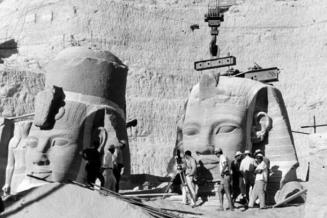
Today, the four majestic statues that guard the entrance to the great temple stare at the river and the rising sun every day. As they did 3,000 years ago. The success of the international cooperation to save Abu Simbel raised awareness about the fact that all over the world there are places of outstanding universal value. Just like the Nile valley temples, they must be protected from many threats such as armed conflict, deliberate destruction, economic pressure, natural disasters and climate change.
The World Heritage Convention was adopted in 1972 as the most important global instrument to establish this notion, bringing all nations together in the pursuit of the preservation of the World’s Natural and Cultural Heritage. With its 194 signatory Member States, it is today one of the world’s most ratified conventions.
How is a site inscribed on the UNESCO World Heritage List?
For a site to be inscribed on the UNESCO World Heritage List, it must first be nominated by the country where it is located. The nomination is examined by international experts who decide whether the inclusion is justified. Finally, the World Heritage Committee, a body of 21 UNESCO elected Member States, takes a vote.
Venice – Can the safeguard of cultural heritage and global tourism coexist?

Launched only a few years after the Nubian temples initiative, the safeguarding campaign for Venice was a response to various challenges including the rising waters and the explosion of global tourism.
Stepping outside the railway station early on an autumnal morning, visitors are met with the view of the chilly air colliding with the water, forming a thick, soft blanket of fog over the Grand Canal, the ‘main street’ of Venice. The church of San Simeone Piccolo, with its oversized dome and slender neoclassical columns, and the neighbouring buildings appear to be floating on the water of the lagoon. It’s a sight that has welcomed millions of visitors from all over the world since the heydays of the Serenissima, when the city ruled as one of Europe’s economic superpowers.
Yet, the breath-taking beauty that inspired countless painters, writers and artists over the centuries remains fragile and at risk of being lost forever. Like the Abu Simbel temples, the city’s survival is threatened by rising water levels. The inexorable increase in sea level has caused flooding to become a regular occurrence. Humidity and microorganisms are eating away the long wooden piles that early dwellers drove deep into the muddy ground of the lagoon to build the first foundations of Venice, 1,600 years ago.

After 1966, the year of the worst flooding in Venice’s history, UNESCO and the Italian Government launched a major campaign to save the city. An ambitious project involving giant mobile flood gates was undertaken to temporarily isolate the lagoon from the high tides and protect the lowest areas from flooding. Thirty years later there is unanimous agreement on the successful results both of the technical achievements and international cooperation.
But Venice still needs attentive care, and its continued survival calls for unflagging vigilance. The city remains threatened on several fronts – mass tourism, the potential damage of subsequent urban development and the steady stream of giant cruise ships crushing its brittle foundations.
International mobilization and pressure around the status of Venice led to the Italian Government’s decision in 2021 to ban large ships from the city centre, as a necessary step to protect the environmental, landscape, artistic and cultural integrity of Venice. This decision came a few days after UNESCO announced its intention to inscribe the city on its World Heritage in Danger list. Until a permanent big cruise docking place is identified and developed, liners will be permitted to pull up in Marghera, an industrial suburb of Venice. Such decisions illustrate the great complexity of protecting historic cities and cultural heritage urban centres, which in this particular situation called for tailor-made measures and techniques different from those implemented for the safeguarding of the fabled Egyptian temples.
If every museum in the New World were emptied, if every famous building in the Old World were destroyed and only Venice saved, there would be enough there to fill a full lifetime with delight. Venice, with all its complexity and variety, is in itself the greatest surviving work of art in the world.

Angkor – A successful example of longstanding international cooperation
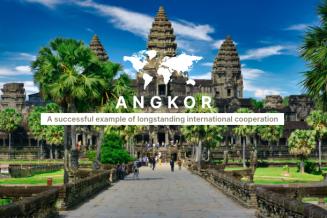
Deep in the forests of Cambodia, in the Siem Reap Province, the five lotus-flower-shaped towers of majestic Angkor Wat soar towards the sky. When approaching from the main gate, the vast scale of the temple and the precise symmetry of the buildings are awe inspiring. This is the world's largest religious monument.
Angkor Wat was part of a sprawling city as big as London, the heart of an empire that between the 9th and 15th centuries extended from southern Vietnam to Laos, and from the Mekong River to Eastern Myanmar. By around 1500 A.D., the Khmer capital was abandoned, most likely after heavy floods and lengthy droughts. Its temples, buildings and complex irrigation network were swallowed by the surrounding forests and lay hidden until their rediscovery in 1860.
By the early 1990s, the site was under major threat, with many of the temples at high risk of collapse and several sites looted. Conservation work at Angkor had not been possible since the outbreak of the civil war, the rise of the Khmer Rouge regime and the following civil unrest.
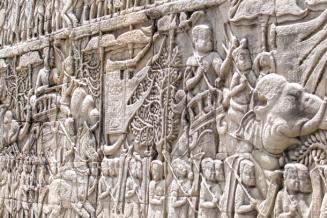
Angkor Wat’s inclusion in UNESCO’s World Heritage List in 1992 marked a milestone in the country’s recovery after years of conflict. The UNESCO-backed preservation of the temples aimed to assist in nation-building and national reconciliation. The action of the International Coordinating Committee (link is external) (ICC-Angkor) for the safeguarding and development of this exceptional cultural site is a striking example of international solidarity and testifies to one of UNESCO's most impressive achievements for heritage. Thirty countries and an ad hoc experts group for scientific, restoration and conservation projects were brought together under an innovative approach, closely linking safeguarding operations to sustainable development efforts.
In 25 years, Angkor has thus become a living laboratory demonstrating the potential of sustainable tourism and crafts, with the mobilization of local communities for social cohesion in 112 villages. The gigantic site now supports 700,000 inhabitants and attracts some five million visitors whose flow must be managed each year. The park authorities are carrying out several projects aimed at improving the lives of communities through the implementation of sustainable tourism that respects local sensitivities. The removal from UNESCO’s List of World Heritage in Danger just fourteen years later is a credit to the Cambodian people.
The fact that a project of such magnitude was successfully carried out in a country emerging from more than two decades of conflict in 1992 is a testament to the potential of the World Heritage Convention and the international solidarity led by UNESCO.
Walking through the temple, I saw reminders of the prosperous civilization that built it: hundreds of beautiful figures carved into the walls telling the stories of these ancient people; wide galleries they must have prayed in; long hallways lined with pillars they must have walked down.
No one knows for sure what caused the empire to abandon this temple and the surrounding city, but in the 15th century almost everyone left. Trees grew over the stones. Only Buddhist monks stayed behind to care for — and pray in — the hidden temples.
But that didn’t stop pilgrims and visitors from continuing to journey here to take in these incredible structures. And now, centuries later, I couldn’t be more thankful to count myself as one of these visitors

Mostar – Symbols do matter, in war and peace
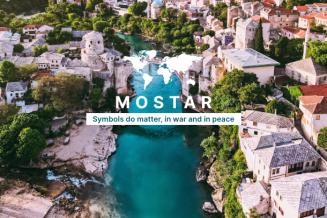
It’s the end of July in Bosnia-Herzegovina. Peak summer means an influx of tourists to the cobbled alleys of Mostar. The cosy medieval town has a long, rich history marked by the peaceful coexistence of three communities: Muslim Bosniaks, Orthodox Serbs and Catholic Croats. Once they arrive in town, visitors from all over the world make a beeline for Mostar’s most emblematic monument, the Old Bridge.
A masterpiece of Ottoman architecture, Stari Most – as it’s known locally – is a symbol of the different communities that have existed side-by-side in the area. Since the 16th century, the bridge had brought them together across the Neretva river – until the Bosnian war. The bridge was a symbol of unity between the Bosnian community (Muslim), in the east of the city, and the Croats and Serbs to the west. The bridge of Mostar (of Ottoman, therefore Muslim origin) served as a link between all these communities – as a pedestrian bridge, it had no military or strategic value. Its destruction in 1993 was only meant to force the communities to separate, to deny their mixing with their neighbours. The bridge was in ruins and, with it, the values of peace and understanding this centuries-old structure had embodied.
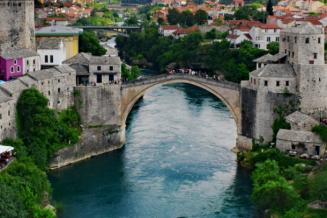
Five years later, UNESCO coordinated a reconstruction project to rebuild the Old Bridge. Despite the scars of the war that are still visible today on the city walls, the reconstructed bridge has now become a symbol of reconciliation and post-conflict healing.
Today, the crowds jam the street to watch the traditional diving contest from the top of the bridge, a long-held custom resumed once Stari Most was restored to its former glory. Every July, young people of Mostar’s three communities compete with courage by jumping into the river 29 metres below, just like they did before the war.
For over four years after the ceasefire, former enemies worked together to retrieve the stones from the riverbed and rebuild their former symbol of friendship. Reconstructed in 2004 and inscribed on UNESCO’s World Heritage list in 2006, Stari Most today is a bridge between a common past and a common future. It is certainly not enough to rebuild a bridge to restore confidence and rebuild peace in a war-torn society. But it certainly matters to care for the symbols of peace.
I was in my office, working to the sound of mortar fire, when we heard the cries in the street – cries that the bridge had fallen. And what happened then was so impressive that I will never forget it. Everyone came out to see. Grenades and bombs were falling everywhere, but still they came out of their hiding places: young and old, weak and strong, Muslim and Christian, they all came, all crying. Because that bridge was part of our identity. It represented us all.
Timbuktu – When warlords target heritage, peacemakers respond with more heritage

Sitting at the gateway to the Sahara Desert, Timbuktu conjures images of a mythical city at the end of the world, where Arab and African merchants would travel from afar to trade salt, gold, cattle and grain. In the English language, the city in northern Mali has come to represent a place far away. Undaunted, caravans still ply the cross-desert route and come to the city several times a year. They carry rock salt extracted from the northern Sahara, just like their ancestors did for centuries.
In its heyday, during the 16th century, the city had 100,000 inhabitants, as its mosques and holy sites played an essential role in the spread of Islam in Africa. The city became an important centre of learning in Africa and its libraries the repository of at least 700,000 historical manuscripts on art, science and medicine, as well as copies of the Qur’an. These manuscripts, written in ornate calligraphy, bear witness to the richness of African history and intellectual life.
During the conflict of 2012–2013, more than 4,000 of the 40,000 manuscripts kept at the Ahmed Baba Institute were lost. Some were burnt or stolen, while more than 10,000 remained in a critical condition. The inhabitants of Timbuktu helped save their precious heritage by secretly spiriting away more than 300,000 manuscripts to the capital, Bamako. Other texts were sheltered between mud walls or buried. Although protected from immediate destruction, the manuscripts are now preserved in conditions that may not safeguard them for future generations.
To help preserve Timbuktu’s cultural heritage and encourage reconciliation, UNESCO has been supporting the local communities to take part in ancient manuscript conservation projects and ensure their lasting preservation for humanity.
UNESCO has coordinated the work to rebuild the fourteen mausoleums inscribed on the World Heritage List, as well as the Djingareyber and Sidi Yaha mosques, that were deliberately destroyed by armed groups during the conflict.
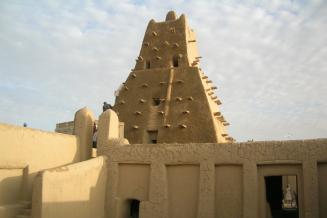
The reconstruction of Timbuktu’s devastated cultural heritage aimed to foster reconciliation among communities and restore trust and social cohesion. An important aspect of the project was the drive to include the reconstruction of the mausoleums in an overall strategy aimed at revitalizing building traditions and ensuring their continuity, through on-the-job training activities and conservation projects.
To ensure the rebuilt shrines matched the old ones as closely as possible, the reconstruction work was checked against old photos and local elders were consulted. Local workers used traditional methods and local materials, including alhor stone, rice stalks and banco – a mixture of clay and straw.
The destruction of the mausoleums of Timbuktu has been a shock, and a clear turning point revealing the importance taken of culture and heritage in modern conflicts fuelled by violent extremism and fundamentalist ideologies. It has shown how strongly fundamentalists are willing to destroy other Islamic cultures, and any other vision which differs from their own. Similar direct destruction of Islamic, pre-Islamic, Christian or Jewish heritage, has then been seen in Iraq and Syria. The need to restore heritage has become far more than a mere cultural issue – it has become a security issue, and a key component for the resilience and further cohesion of societies torn by conflicts.
At present, the monuments in Timbuktu are living heritage, closely associated with religious rituals and community gatherings. Their shape and form have always evolved over time both with annual cycles (that of the rain and the erosion of the plastering); that of regular maintenance (every three to five years); repairs of structural pathologies, often adding buttresses; and at times more important works, including extensions and raising of the roof structure. How to take that into account while trying to guide and assist the local people in their self-capacity, their resilience in keeping their heritage as they have done for over 600 years? What should be done and to what extent? Who should be responsible for what? These are tricky questions of heritage preservation, far beyond the mere inscription of a site on the famous World Heritage list.
Salt comes from north, gold from south and silver from the land of Whites, but the Word of God, the famous things, histories and fairy tales, we only find them in Timbuktu.
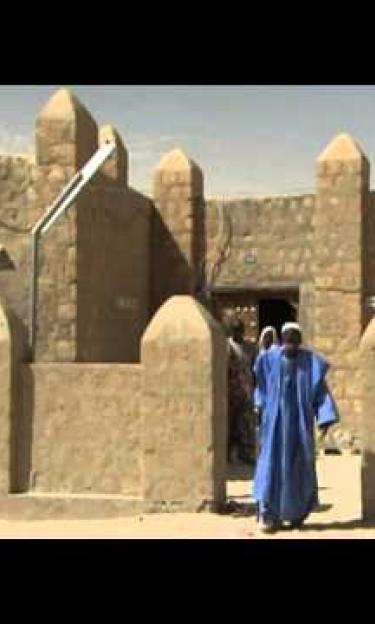
Preserving cultural identity and Korean traditions: The bond of living heritage

It’s the end of November in the countryside near Jeonju, the capital of the North Jeolla Province. The weather is getting chilly and winter is just a couple of weeks away.
It’s time to prepare for the long, icy-cold season. It’s time to make kimchi.
The Republic of Korea’s staple food is a side dish of salted and fermented vegetables that makes its appearance at every meal. It’s not just the country’s emblematic dish: its preparation ( kimjang ) is a community event.
Housewives monitor weather forecasts to determine the most favourable date and temperature for preparing kimchi. Entire families, friends and neighbours gather together to make it. The process is rather laborious and requires many hands to process the large quantities of vegetables required to last throughout the winter months. They all work together, exchange tips and tighten their relationships through kimjang. Families take turns making kimchi to form closer bonds.
Today, the entire village will get together in one of the houses for the occasion. Together, they will wash the napa cabbage that was pickled in salt the night before and mix in the seasonings that will give kimchi its unique sour-and-spicy flavour. The specific methods and ingredients are transmitted from mother to daughter so that kimjang culture is preserved through the generations.
Since 2013, kimjang has been included in UNESCO’s Representative List of the Intangible Cultural Heritage of Humanity as an important part of Korean culture, embodying the country’s cooperative and sharing team spirit. Kimjang is a vital cultural asset of a community and worth preserving and celebrating for the rest of humanity. Even though there may be regional differences in the preparation of kimchi, it transcends class, regional and even national borders.
Cultural practices often precede the instauration of national borders and the start of conflict among its citizens. Shared cultural practices may even be a path to reconciliation.

Such hopes materialized in 2018, when the Democratic People’s Republic of Korea and the Republic of Korea decided to work together to submit a joint submission for traditional wrestling as an element of UNESCO’s Representative List of the Intangible Cultural Heritage of Humanity.
Ssirum/Ssireum (wrestling) is a physical game and a popular form of entertainment widely enjoyed all across the Korean peninsula. In the North, two opponents try to push each other to the ground using a satpa (a fabric strap connecting the waist and leg), their torso, hands and legs. Ssirum/Ssireum is distinguished by the use of the satpa and the awarding of a bull to the winner. In the South, Ssirum/Ssireum is a type of wrestling in which two players wearing long fabric belts around their waists and one thigh grip their opponents’ belt and deploy various techniques to send them to the ground. The winner of the final game for adults is awarded an ox, symbolizing agricultural abundance, and the title of ‘Jangsa’.
As an approachable sport involving little risk of injury, Ssirum/Ssireum also offers a means to improve mental and physical health. Koreans are widely exposed to Ssirum/Ssireum traditions within their families and local communities: children learn the wrestling skills from family members; local communities hold annual open wrestling tournaments; its instruction is also provided in schools.

Following UNESCO’s mediation, the two States Parties agreed for their respective nomination files to be jointly examined by the Intergovernmental Committee for the Safeguarding of Intangible Cultural Heritage in November 2018. UNESCO welcomed this initiative of regional cooperation and, through a historic decision, inscribed "Traditional Korean wrestling (Ssirum/Ssireum)" on the Representative List of the Intangible Cultural Heritage of Humanity, as a joint inscription from the Democratic People’s Republic of Korea and the Republic of Korea. While the Lists of the Convention include several examples of multinational nominations prepared by several States (from couscous to the art of falconry and the Mediterranean diet), the coming together of the two States Parties for the joint inscription of Korean traditional wrestling by the Committee is unprecedented. It marks a highly symbolic step on the road to inter-Korean reconciliation. It is also a victory for the longstanding and profound ties between both sides of the inter-Korean border, and for the role cultural diplomacy may have in international relations.
It was the time when the women would gather and gossip. There would be matchmaking. There would be some marriages that came about during the time of kimchi making.


Promoting culture in a post-COVID-19 world
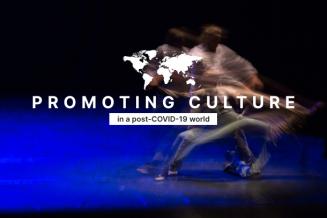
The cultural and creative industries are among the fastest growing sectors in the world. With an estimated global worth of US$ 4.3 trillion per year, the culture sector now accounts for 6.1 per cent of the global economy. They generate annual revenues of US$ 2,250 billion and nearly 30 million jobs worldwide, employing more people aged 15 to 29 than any other sector. The cultural and creative industries have become essential for inclusive economic growth, reducing inequalities and achieving the goals set out in the 2030 Sustainable Development Agenda.
The adoption of the 2005 Convention for the Protection and Promotion of the Diversity of Cultural Expressions was a milestone in international cultural policy. Through this historic agreement, the global community formally recognized the dual nature, both cultural and economic, of contemporary cultural expressions produced by artists and cultural professionals. Shaping the design and implementation of policies and measures that support the creation, production, distribution of and access to cultural goods and services, the 2005 Convention is at the heart of the creative economy.
Recognizing the sovereign right of States Parties to maintain, adopt and implement policies to protect and promote the diversity of cultural expression, both nationally and internationally, the 2005 Convention supports governments and civil society in finding policy solutions for emerging challenges.
Based on human rights and fundamental freedoms, the 2005 Convention ultimately provides a new framework for informed, transparent and participatory systems of governance for culture.

A constant rethinking of culture and heritage
The history of UNESCO bears witness to the deep transformation of the concept of culture over the past decades. From global Conventions mostly dealing with building and stones in the 60’s and 70’s, the international cooperation opened new fronts for the protection and promotion of culture, including intangible cultural heritage, cultural diversity and creative economy. The definition of "culture" was spearheaded by the committee led by former UN Secretary-General Javier Pérez de Cuellar and the Mondiacult Conference in 1982. In 2022, the global Mondiacult conference is expected to take stock of progress made in the past 40 years in cultural policies, and re-imagine its future in a post-COVID-19 world.
Have a look at these World Heritage sites
The 30,000-kilometre-long road system was built by the Inca Empire across mountains, valleys, rainforests and deserts to link the Inca capital, Cuzco, with distant areas of the empire, from the Amazon to the Andes. Thanks to its sheer scale, Qhapaq Ñan is a unique achievement of engineering skills, highlighting the Incas' mastery of construction technology.
The granting of World Heritage status in 2019 has made its trail – which every year sees thousands of visitors on their way to the area’s archaeological sites such as Machu Picchu in Peru – eligible for much-needed restoration funds.
Borobudur Temple Compound
Borobudur is the largest Buddhist temple in the world and one of the great archaeological sites of Southeast Asia. This imposing Buddhist temple, dating from the 8th and 9th centuries, is located in central Java. It was built in three tiers: a pyramidal base with five concentric square terraces, the trunk of a cone with three circular platforms and, at the top, a monumental stupa. The walls and balustrades are decorated with fine low reliefs, covering a total surface area of 2,500 m 2 . Around the circular platforms are 72 openwork stupas, each containing a statue of the Buddha. The monument was restored with UNESCO's help in the 1970s.
Bamiyan Valley, Afghanistan
This cultural landscape was simultaneously inscribed on the World Heritage List and the List of World Heritage in Danger in 2003. The property is in a fragile state of conservation, having suffered from abandonment, military action and dynamite explosions. Parts of the site are inaccessible due to the presence of anti-personnel mines.
Related items
- Lists and designations
- Intangible cultural heritage
- Intangible heritage
- Diversity of Cultural Expressions-2005 Convention
- Intangible Cultural Heritage-2003 Convention
- Underwater Cultural Heritage-2001 Convention
- World Heritage 1972 Convention
- Fight Illicit Trafficking-1970 Convention
- Armed Conflict and Heritage-1954 Convention
- Culture & Sustainable Development
- UNESCO Creative Cities Network
The Importance of Cultural Heritage Tourism
(Click on image to see larger view)
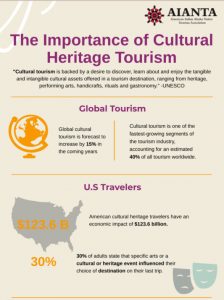
“Cultural tourism is backed by a desire to discover, learn about and enjoy the tangible and intangible cultural assets offered in a tourism destination, ranging from heritage, performing arts, handicrafts, rituals and gastronomy.” -UNESCO
Global Tourism
Global cultural tourism is forecast to increase by 15% in the coming years
Cultural tourism is one of the fastest-growing segments of the tourism industry, accounting for an estimated 40% of all tourism worldwide.
U.S Travelers
American cultural heritage travelers have an economic impact of $123.6 billion.
30% of adults state that specific arts or a cultural or heritage event influenced their choice of destination on their last trip.
Cultural Tourism Spending
Rural arts organizations attract more outside visitors than urban arts organizations ( 31% vs 14% ). These visitors spend money on admissions, parking, dining, etc., contributing directly to local economies.
49% of cultural travelers will pay more for lodging that has a distinctive cultural or heritage component (historic building, local art or decor, architecture, etc.)
Types of Cultural Heritage Tourism
- Culinary tourism, food sovereignty
- National & regional parks, eco-tourism, wildlife tourism
- Sports, games & other athletic events
- Museums. libraries & cultural centers
- Annual festivals, powwows, major events
- Historic sites & commemorations
- Rivers, trails & conservation areas
- Hogans, earth lodges, longhouses, clan houses
- Agritourism
- Performing arts & storytelling
Economic Benefits of Cultural Heritage Tourism
- Injects new money into the economy, boosting businesses and tax revenues
- Creates new jobs
- Funds new businesses, events and attractions, helping diversify the local economy
- Supports small businesses, including artists, local guides, educators
- Helps increase a customer base for local businesses
- Promotes the active preservation and protection of important local resources
- Allows tribes and indigenous communities to define and tell their own stories
MyTravel Resources.com The Goss Agency Inc. UNESCO Mandala Research NEA: Rural Arts, Design & Innovation in America Study

- PUBLICATIONS
- GRAPHICS WAREHOUSE
- SCRUTINY TOOLBOX
The impact of climate change on cultural heritage
The rapid increase in the frequency of climate related extreme events necessitate deep investigation into their consequences for the cultural heritage sector.

Written by Magdalena Pasikowska-Schnass.
Climate change, a global phenomenon, affects every aspect of our lives, including cultural heritage in both its forms – tangible and intangible. Extreme weather conditions expose these important elements of our cultural identity to serious threats. These threats must be addressed to protect valuable sites and preserve them for future generations.
Research on climate change is not a novelty, but climate change as it relates to cultural heritage is a relatively new area of exploration and policy. The impact of climate change on cultural heritage made its way to the Conference of the Parties to the United Nations Convention on Climate Change in Madrid in 2019 (COP25) and has become increasingly visible at subsequent COPs.
In 2003, the European Commission became the first European Union institution to launch a research project addressing the intersection of climate change and cultural heritage. Since then, the EU has expanded the scope and scale of its projects in this policy area. The EU’s competence in cultural policy is limited to providing funds, which it does in the areas of cooperation, networking, exchange of best practices, research and education. Despite this limitation, EU‑level policies offer a broad perspective, much needed given the interdisciplinary and global nature of this issue.
The dual challenge of climate change and protection of cultural heritage does not often feature clearly in European Parliament resolutions or European Commission policy documents. However, policy instruments are indeed available, and an integrated approach including not only economic, but also social, environmental, sustainability and identity dimensions of this complex issue is well underway.
Read the complete briefing on ‘ The impact of climate change on cultural heritage ‘ in the Think Tank pages of the European Parliament.
Members' Research Service
Investment in artificial intelligence in the national recovery and resilience plans, digital public services in the national recovery and resilience plans: mid-term multilevel governance appraisal, timeline to new eu institutional leadership, rules on ‘revolving doors’ in the eu: post-mandate restrictions on members of eu institutions and parliamentarians in member states, ‘sahelexit’ in west africa: implications for ecowas and the eu, plenary round-up – april ii 2024, protecting children in virtual worlds (the metaverse), artificial intelligence and cybersecurity, the six policy priorities of the von der leyen commission: an end-of-term assessment, outcome of the special european council meeting of 17-18 april 2024, ‘this is europe’ debates in the european parliament, 2022-2024.
Be the first to write a comment.
Leave a Reply Cancel reply
- What Europe does for me

EU legislation in progress

Download the EPRS App

- EP Plenary Sessions
- Cost of Non-Europe reports
- Latest Media
- Climate Change
- Russia's war on Ukraine
We write about
- Replies to campaigns from citizens
- What Europe does for you
- Economic and Social Policies
- EU Financing / Budgetary Affairs
- Institutional and Legal Affairs
- International Relations
- Policy Cycle
- Structural and Cohesion Policies
RSS Link to Members’ Research Service
Social media.
- EP Think Tank
- Write to the European Parliament
- EP Library catalogue
Disclaimer and Copyright statement
The content of all documents (and articles) contained in this blog is the sole responsibility of the author and any opinions expressed therein do not necessarily represent the official position of the European Parliament. It is addressed to the Members and staff of the EP for their parliamentary work. Reproduction and translation for non-commercial purposes are authorised, provided the source is acknowledged and the European Parliament is given prior notice and sent a copy. For a comprehensive description of our cookie and data protection policies, please visit Terms and Conditions page. Copyright © European Union, 2014-2024. All rights reserved.
Discover more from Epthinktank
Subscribe now to keep reading and get access to the full archive.
Type your email…
Continue reading

- Privacy Overview
- Strictly Necessary Cookies
- Cookie Policy
This website uses cookies so that we can provide you with the best user experience possible. Cookie information is stored in your browser and performs functions such as recognising you when you return to our website and helping our team to understand which sections of the website you find most interesting and useful.
Strictly Necessary Cookie should be enabled at all times so that we can save your preferences for cookie settings.
If you disable this cookie, we will not be able to save your preferences. This means that every time you visit this website you will need to enable or disable cookies again.
More information about our Cookie Policy .
The present website is hosted by WordPress.com, a service by Automattic. Automattic is a global company with thousands of servers located in several separate data centres around the world. While Automattic takes care of the security of the platform , we, the European Parliamentary Research Service, own the content of the blog. For more detailed information about the compliance of Automattic products and services with the EU General Data Protection Regulation (GDPR), please see their dedicated page .
Data collected
We do not collect any personal data that could identify an individual user. The users that are registered in WordPress.com should consult wordpress.com terms of service . We do collect anonymised aggregate data for statistical purposes. The data collected for this purposes include: number of visits/visitors per page, the country of the user, and aggregate numbers of incoming and outgoing clicks.
We determine unique page counts by using a “hashed” version of the visitor’s IP address. The visitor’s full IP address is deleted from our logs after a little over a month. That timeframe is how long the data is needed in order to allow us to calculate your stats on a monthly basis and no longer.
We collect your email address only if you proactively requested to be notified about the updates on the blog. You can always contact us to remove your email address from our records or unsubscribe from the notification service.
We can also see your name and email address if you made a comment to one of our posts. We do not make the email address visible on the comment. Nevertheless, on request, we can delete your comments.
We collect cookies only to facilitate your browsing experience, such as enabling you to share our posts via social media or comment on the post. The majority of cookies will be used only if you are a registered WordPress.com user. In this case, you are bound to WordPress.com terms of service .
Some pages embed content from third parties. In this case, you will need to actively consent to their terms in order to see the content.
We do not collect cookies to show advertisement nor resell any information collected with cookies to third parties. Read more about the wordpress.com cookie policy and the way to control cookies on their dedicated page .
The World Bank Reinforces Its Support for the Development of Resilient Tourism and Blue Economy in Cabo Verde
WASHINGTON, April 30, 2024 - Today, the World Bank approved a credit from the International Development Association in the amount of $30 million for the Second Additional Financing of the Resilient Tourism and Blue Economy Development Project in Cabo Verde, increasing the overall value of this project, initially approved in May 2022, to $75 million.
This new funding emphasizes the importance of tourism and its connections to the blue economy. Its main goal is to support Cabo Verde's overarching strategies for sustainable tourism and the blue economy, as outlined in the Tourism Operational Program and the National Investment Plan for the Blue Economy. By doing so, it aims to promote tourism practices that are environmentally friendly and beneficial to local communities. It also aims to expand on initial objectives by improving the diversity of tourism offerings across different islands and markets. Progress will be measured by metrics like increased tourist spending and longer stays in emerging destinations. Additionally, the project seeks to increase the participation of local communities in the economic benefits of tourism, which will be tracked through the number of contracts awarded to local businesses within the tourism industry.
The project expansion now spans activities across six islands: Santiago, Santo Antão, São Vicente, Sal, São Nicolau, and Boa Vista. These activities include:
i) Improving tourism and blue economy infrastructure: This involves enhancing trekking trails, restoring historical and cultural sites, and upgrading coastal areas, piers, and fishing markets to ensure they support sustainable practices.
ii) Supporting local small and medium-sized enterprises ( SMEs) and women-led businesses: The project will provide tailored assistance to SMEs and businesses led by women. This support will focus on offering sustainable services and products that meet the current demands of the tourism industry and take advantage of the unique opportunities presented by Cabo Verde's blue economy.
iii) Establishing supportive public policies: Efforts will be made to create frameworks for effective public policies, particularly in sectors crucial for sustainable development. This includes initiatives to strengthen governance in sustainable fisheries, creating an enabling environment for the long-term growth of tourism and the blue economy in Cabo Verde.
"The increase in funding for this pivotal project to $75 million — the largest ever provided by the World Bank in Cabo Verde — underscores a firm commitment to advancing the country's development strategy led by the private sector. This commitment extends to exploring opportunities beyond tourism, particularly within the blue economy. The expanded investments in resilient infrastructure, coupled with support programs for local SMEs and sustainable development policies, aim to unlock Cabo Verde's inherent potential and competitive advantages,” said Rosa Brito, Interim Resident Representative for Cabo Verde.
This site uses cookies to optimize functionality and give you the best possible experience. If you continue to navigate this website beyond this page, cookies will be placed on your browser. To learn more about cookies, click here .
- Logout Login
- Adventure Holidays
- Weekend Getaways
- Driving Holidays
- Travel News
Top Searches
World Smart Cities
India Heritage Sites
Kota Tourist Zone
Tiger Spotting Tips
Dubai Flight Advisory
Densely Populated Countries
Vietnam: Decoding the cultural and natural beauty of Da Nang
Times of India TIMESOFINDIA.COM / TRAVEL TRENDS , VIET NAM / Updated : May 2, 2024, 19:17 IST
You're Reading
Exploring Da Nang in Central Vietnam unveils a mix of history, culture, and natural beauty. From stunning beaches and iconic bridges to vibrant culinary scenes and rich heritage, these destinations offer a memorable travel experie … Read more
Exploring Da Nang in Central Vietnam unveils a mix of history, culture, and natural beauty. From stunning beaches and iconic bridges to vibrant culinary scenes and rich heritage, these destinations offer a memorable travel experience. Read less
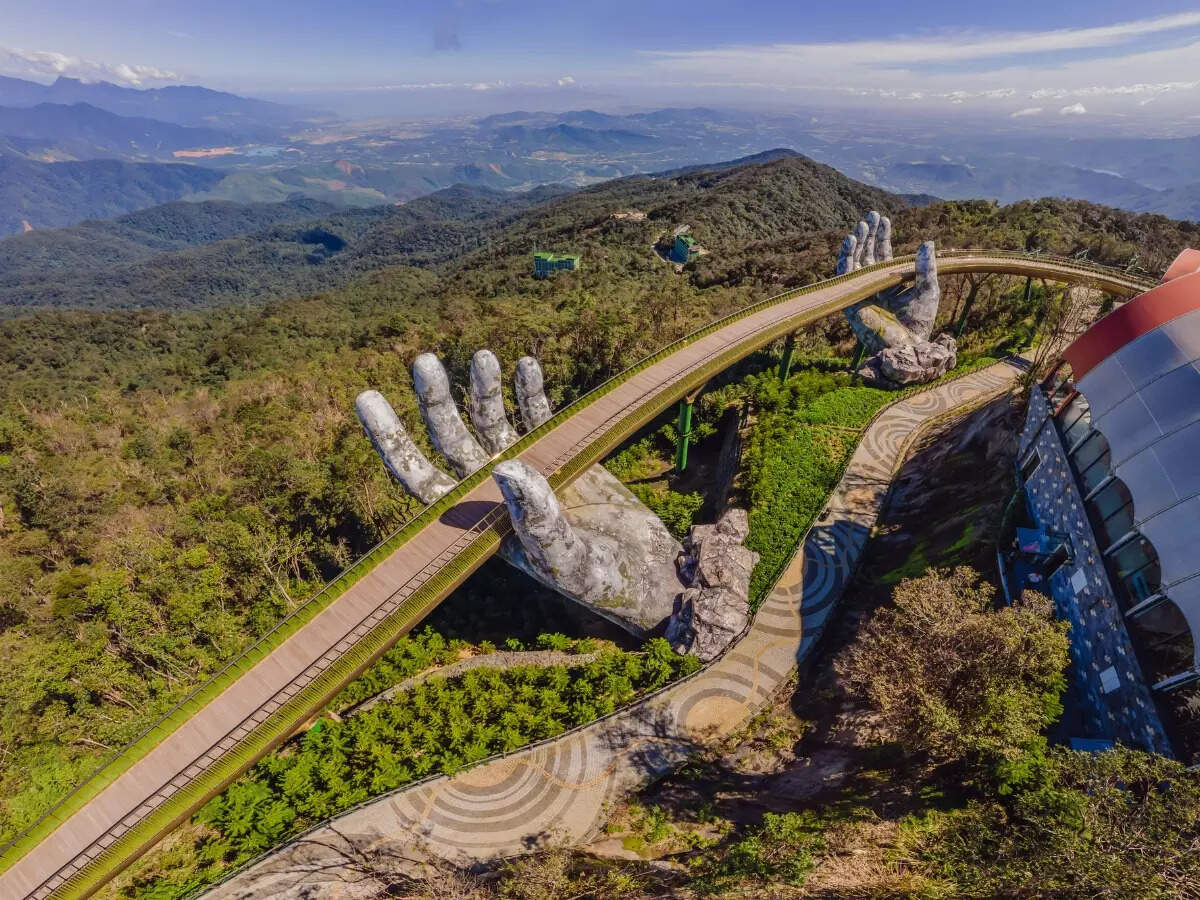
10 oldest national parks in India
More from travel news.

Comments (0)

Refrain from posting comments that are obscene, defamatory or inflammatory, and do not indulge in personal attacks, name calling or inciting hatred against any community. Help us delete comments that do not follow these guidelines by marking them offensive . Let's work together to keep the conversation civil.
Comments ( ) Sort: Newest UpVoted Oldest Discussed Down Voted closecomments

SIGN IN WITH
Or post without registration.

Visual Stories
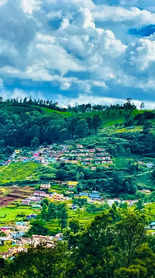
Popular Galleries
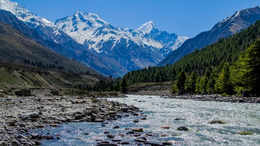
Prettiest places in Himachal Pradesh to explore this summer TRAVEL TRENDS , HIMACHAL PRADESH

Exploring India's 8 oldest heritage sites TRAVEL TRENDS , INDIA

World’s top 6 smart cities! TRAVEL NEWS , WORLD
Trending stories.
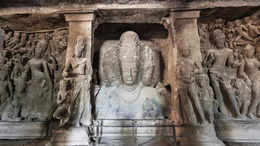
How to reach Elephanta Caves in Mumbai?

5 exclusive experiences you can have only in the Andamans!

What’s it like to visit Chitkul, India’s last village on the Indo-Tibetan border?

- Uttarakhand Tourism launches 'Nakshatra Sabha': India's first astro tourism campaign

6 tips to spot tigers in the wild!
- 1 Vietnam: Decoding the cultural and natural beauty of Da Nang
- 2 Fly-cruise to the enchanting continent of Antarctica, the last frontier
- 3 Decoding Devil's Tower, and why was it named so?
- 4 How to book your Kedarnath Yatra Helipad service in 2024?
- 5 5 breathtaking temples to visit in India

THE DEFINITIVE GUIDE TO DESTINATIONS, ITINERARIES, THINGS TO DO, RESTAURANTS, NIGHTLIFE and LOTS MORE!
FOLLOW US ON
Places to visit.
- Places to visit in Bangalore
- Places to visit in Mumbai
- Places to visit in Delhi
- Places to visit in Goa
- Hotels in Goa
- Hotels in Jaipur
- Hotels in Shimla
- Hotels in Mumbai
Things To do
- Things to do in Goa
- Things to do in Mumbai
- Things to do in Bangalore
- Things to do in Delhi
Travel Inspiration
- Visa on arrival for Indians
- Honeymoon Places in india
- Hill Stations in India
- Weekend getaways in Mumbai
- Weather in Delhi
- Weather in Chennai
- Weather in Bangalore
- Weather in Mumbai
Best Beaches
- Goa Beaches
- Mumbai Beaches
- Pondicherry Beaches
- Kerala Beaches
- Restaurants in Bangalore
- Restaurants in Chennai
- Restaurants in Pune
- Restaurants in Jaipur
- Hill Station near Delhi
- Winter trip to Ladakh
- Places to visit in Kerala
- Winter Honeymoon Destinations
- UK visa guide for Indians
- Winter Trip to Manali
- Vaishno Devi Yatra
- Special Train Ticket Booking
- HP inter-state Bus
- Honeymoon Destinations India
Latest News
- All about Floating Glass Museum, built to highlight and flight climate change
- Kota Tourist Zone, Corbett’s new zone, is now open to the public
- Scientists discover world’s deepest blue hole in Mexico!
- Scientists discover gigantic ocean 700 km beneath the Earth’s surface
- 5 breathtaking temples to visit in India
- The rise of Eco-Friendly travel: Top destinations for sustainable tourism
Congratulations!
You have been successfully added to the mailing list of Times of India Travel. To complete the subscription process, kindly open your inbox and click on the confirmation link which has been emailed to you.
Share with friends
Thank You for sharing! Your friend will receive the article link on email mentioned.
- (For more than one recipient, type addresses separated by commas)
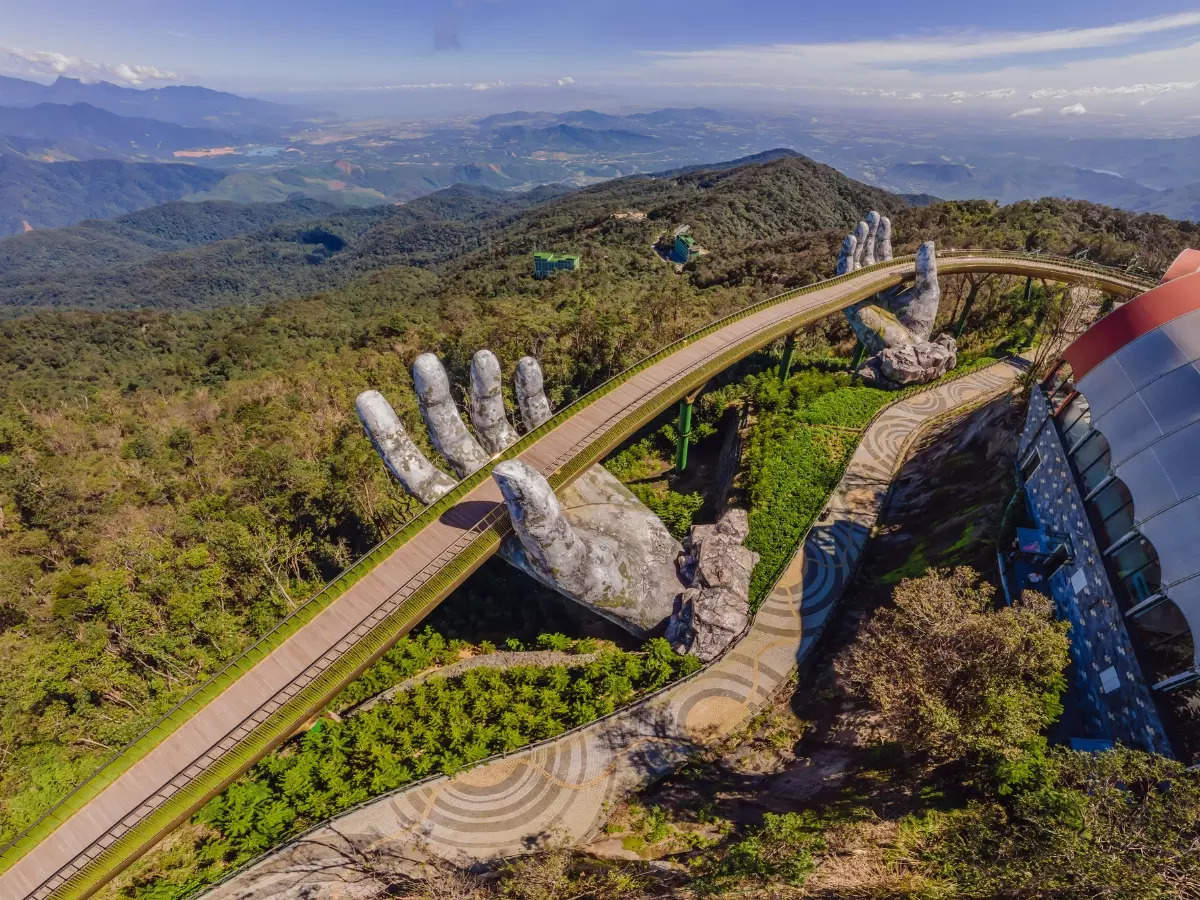
Exploring Da Nang in Central Vietnam unveils a mix of history, culture, and natural beauty. From stunning beaches and iconic bridges to vibrant culinary scenes and rich heritage, these destinations of...
San Diego Travel Blog
Local insight to help you plan your next San Diego vacation.

April 30, 2024 By Julia Buescher
Celebrating Asian-Pacific Heritage: A Taste of Culture with Cristian Liang
Cristian Liang is a San Diego restaurant owner who embodies the cultural richness of our region. He’s an Asian-American entrepreneur who was born across the border in Baja California and now co-owns a trio of popular pan-Asian eateries in San Diego: Common Theory Public House , Realm of the 52 Remedies and Woomiok . To mark Asian Pacific American Heritage Month, we caught up with Cristian and chatted about his success story, some favorite dishes and where he goes to celebrate his heritage.
Q : Tell us a little about yourself and what inspired you to launch your businesses — as well as why you felt San Diego was the right place to do so.
A : I was born in Rosarito, Baja California, Mexico. My parents owned and operated a Chinese restaurant in Tijuana for over 30 years, and I went to school in Tijuana until the age of 14. Entrepreneurship is the main reason for starting my own business, and I guess since the restaurant business is in my blood, I felt comfortable getting into the hospitality industry as my first business venture.
Q : What are some of your recommended must-try item(s) on the menus at your restaurants:
A : Common Theory Public House – Szechuan Hot Fried Chicken Sandwich; Realm of the 52 Remedies – “KFQ,” or Korean-Fried Quail, paired with Saigon Dreamer cocktail.
Ingredients: “KFQ” Korean-Fried Quail, Yuzu Honey Sambal, Almond Gremolata, Fish Sauce, Candied Orange Peel, Thai Basil Saigon Dreamer Mr. Black Cold Brew Coffee Liqueur, Michter’s Rye Whiskey, Creme de Cacao, Lemon, Pineapple, Sugar, Clarified with Whole Milk. (Citrusy and nutty.)
Q : What are a few of your local favorites within your neighborhood?
A : Woomiok , Chon Ju Jip , and Matoi .
Q : If someone were to come to your business, what are a few surrounding things that would be interesting to do?
A : Eating and grabbing dessert on Convoy is the best! This neighborhood has an amazing variety of Asian eateries. Once your belly is full, go out for some boba pearl tea or sweet desserts from a local bakery or some shaved ice!
Q : Locally, where do you go to connect with your heritage?
A : Everywhere on Convoy connects me to my Chinese background, especially all the Asian grocery stores like 99 Ranch Market and H Mart! I’m able to find all the Asian ingredients I need for home and businesses, as well as all the snack favorites I loved since my childhood days.
Q : What are your favorite AAPI-centered events, neighborhoods, museums and other highlights in San Diego?
A : Chinese New Year celebration at Common Theory is always fun; we hire the local group of Lucky Lion Dancers to perform at the restaurant. We also hand out to every guest a traditional red pocket (pre-filled with a lucky $1 dollar bill) so that each guest can feed the dancing lions the lucky money for good luck, good health and prosperity!
Q : If someone were coming to San Diego for the first time, what would you tell them to do? (Besides visit your business, of course!)
A : I would recommend they explore the craft beer scene , visit Balboa Park , go to the beach in the spring/summer, and then come back to Convoy for dinner and drinks at Realm of the 52 Remedies before leaving town!
Q : What do you think would most surprise a newcomer to San Diego?
A : It’s not a surprise, but they will find that the city has many beautiful beaches, friendly people with laid-back vibes, and the best weather in the States. This is why people visit and end up staying!
Q : Looking forward, what makes you excited about growing your business in San Diego?
A : The potential in this city, and the appetite San Diegans have for better food , better drinks , and better experiences . As long as we continue to create concepts that focus on those three things, we can keep growing.
Tourism Impacts on Heritage Sites in Japan: From Government’s View to Local People’s Awareness
- Conference paper
- First Online: 04 October 2022
- Cite this conference paper

- Hoa Nguyen Quynh 23
Part of the book series: Advances in Science, Technology & Innovation ((ASTI))
380 Accesses
Culture and heritage have been a major part of travel as their contribution to a tourism destination’s appealing. Recently, heritage tourism is the fastest-growing segment of the tourism industry as the volume of tourists seeking adventure, culture, history, archeology, and interaction with local people is increasing. Heritage tourism gives positive economic and social impacts, establishes and reinforces identity, and helps preserve the cultural heritage. However, as the volume of traveling rises, there are negative impacts on local communities in heritage sites that create tensions and conflicts among different stakeholders. Therefore, understanding the tourism policymakers’ view and local people’s awareness of tourism impacts is not only useful in the conservation of a heritage site, but it also contributes to promote the image of that destination and balance the stakeholders’ benefits. This paper aims to study (1) the tourism impacts on local community, (2) the local people’s awareness and consideration between positive impacts and negative impacts, and (3) the difference between government policymakers and local people’s points of view about tourism impacts and development. The data were collected from a qualitative survey on Japanese government officers and academic people, and a quantitative survey on 245 local people in some Japanese heritage sites. From the findings, some gaps between government policymakers and local people’s point of view were found and analyzed to contribute to the future tourism policy development for Japan heritage conservation.
This is a preview of subscription content, log in via an institution to check access.
Access this chapter
- Available as PDF
- Read on any device
- Instant download
- Own it forever
- Available as EPUB and PDF
- Compact, lightweight edition
- Dispatched in 3 to 5 business days
- Free shipping worldwide - see info
- Durable hardcover edition
Tax calculation will be finalised at checkout
Purchases are for personal use only
Institutional subscriptions
Adongo, R., Choe, J. Y., & Han, H. (2017). Tourism in Hoi An, Vietnam: Impacts, perceived benefits, community attachment and support for tourism development. International Journal of Tourism Sciences, 17 (2), 86–106. https://doi.org/10.1080/15980634.2017.1294344
Article Google Scholar
Agency for Cultural Affair. (2013). White papers and Annual Report. https://www.bunka.go.jp/english/report/annual/
Andereck, K. L., Valentine, K. M., Knoft, R. C., & Vogt, C. A. (2005). Residents’ perceptions of community tourism impacts. Annals of Tourism Research, 32 (4), 1056–1076. https://doi.org/10.1016/j.annals.2005.03.001
Aref, F., Redzuan, M., & Gill, S. S. (2009). Community perceptions toward economic and environmental impacts of tourism on local communities. Asian Social Science, 5 (7), 130–137.
Ashworth, G. J., & Van der Aa, B. J. (2006). Strategy and policy for the world heritage convention: goals, practices and future solutions. In Managing world heritage sites (pp. 173–184). Routledge.
Google Scholar
Boyd, S. W. & Timothy, D. J. (2003). Heritage Tourism . Pearson Education.
Doǧan, H. Z. (1989). Forms of adjustment: Sociocultural impacts of tourism. Annals of tourism research, 16 (2), 216–236. https://doi.org/10.1016/0160-7383(89)90069-8
Estol, J., & Font, X. (2016). European tourism policy: Its evolution and structure. Tourism Management, 52 , 230–241. https://doi.org/10.1016/j.tourman.2015.06.007
Figgis, P., Bushell, R., & Eagles, P. F. (2007). Tourism as a tool for community-based conservation and development. In Tourism and Protected Areas: Benefits Beyond Boundaries: The Vth IUCN World Parks Congress (p. 101). CABI.
Garrod, B., & Fyall, A. (2000). Managing heritage tourism. Annals of Tourism Research, 27 (3), 682–708. https://doi.org/10.1016/S0160-7383(99)00094-8
Girard, L. F., & Nocca, F. (2017). From linear to circular tourism. Aestimum , 70 .
Hall, C. M. (2003). Politics and place: An analysis of power in tourism communities. Tourism in destination communities (pp. 99–114).
Hall, C. M., & McArthur, S. (1998). Integrated heritage management: Principle and practice . Stationery Office.
Hair, J. F., Black, W. C., Babin, B. J., Anderson, R. E., & Tatham, R. L. (1998). Multivariate data analysis . Prentice Hall.
Harrill, R. (2004). Residents’ attitudes toward tourism development: A literature review with implications for tourism planning. Journal of Planning Literature, 18 (3), 251–266. https://doi.org/10.1177/0885412203260306
Hoa, N. Q. (2016). Marketing cultural heritage to promote tourism growth in peripheral areas of vietnam for sustainable economic development. In Proceedings of the Annual Vietnam Academic Research Conference on Global Business, Economics, Finance Social Sciences, Hanoi, Vietnam , August 7–9.
Holden, A. (2000). Winter tourism and the environment in conflict: The case of Cairngorm, Scotland. International Journal of Tourism Research, 2 (4), 247–260. https://doi.org/10.1002/1522-1970(200007/08)2:4%3c247::AID-JTR214%3e3.0.CO;2-X
Hunter, C., & Green, H. (1995). Tourism and the environment: A sustainable relationship? Routledge.
Institute of Population and Social Security Research. (2013). Regional population projection for Japan: 2010–2040 .
Ioannides, D., & Debbage, K. G. (Eds.). (1998). The economic geography of the tourist industry: A supply-side analysis. Psychology Press.
Jaafar, M., Noor, S. M., & Rasoolimanesh, S. M. (2015). Perception of young local residents toward sustainable conservation programmes: A case study of the Lenggong World Cultural Heritage Site. Tourism Management, 48 , 154–163. https://doi.org/10.1016/j.tourman.2014.10.018
JNTO. (2019). Japan Tourism Statistics . https://statistics.jnto.go.jp/en/
Kakiuchi, E. (2014). Cultural heritage protection system in Japan: Current issues and prospects for the future. National Graduate Institute for Policy Studies, 2 , 1–12.
Kakiuchi, E. (2018). Cultural creative industries from a cultural policy perspective: The case of Japan . Edward Elgar Publishing.
Kim, S. (2016). World Heritage Site designation impacts on a historic village: A case study on residents’ perceptions of Hahoe Village (Korea). Sustainability (switzerland), 8 (3), 258. https://doi.org/10.3390/su8030258
King, B., Pizam, A., & Milman, A. (1993). Social impacts of tourism—Host perception. Annals of Tourism Research, 20 (4), 650–665. https://doi.org/10.1016/0160-7383(93)90089-L
Liu, J. C., & Var, T. (1986). Resident attitudes toward tourism impacts in Hawaii. Annals of Tourism Research, 13 (2), 193–214.
Manniche, J., Topsø Larsen, K., Brandt Broegaard, R., & Holland, E. (2017). Destination: A circular tourism economy: A handbook for transitioning toward a circular economy within the tourism and hospitality sectors in the South Baltic Region .
Meethan, K. (2003). Mobile cultures? Hybridity, tourism and cultural change. Journal of Tourism and Cultural Change , 1 (1), 11–28. https://doi.org/10.1080/14766820308668157
Ministry of Internal Affairs and Communications. (2015). Population Census Report—Japan .
Ministry of Internal Affairs and Communications. (2018). Statistical handbook of Japan, 2018 . Statistics Bureau.
Moli, P. (2011). Community-based eco cultural heritage tourism for sustainable development in the Asian region: A conceptual framework. International Journal of Social Ecology and Sustainable Development, 2 (2), 66–80. https://doi.org/10.4018/jsesd.2011040106
Nash, D. (1989). Tourism as a form of imperialism. Hosts and Guests—The Anthropology of Tourism .
Neef, A. (2019). Tourism, land grabs and displacement—A study with particular focus on the global south. Report, Tourism Watch (pp. 27–29).
Nicholas, L. N., Thapa, B., & Ko, Y. J. (2009). Residents’ perspectives of a world heritage site: The Pitons Management Area, St. Lucia. Annals of Tourism Research, 36 (3), 390–412. https://doi.org/10.1016/j.annals.2009.03.005
Tho, N. D. (2012). Scientific research methods in business. Labor and Social Publishing House .
OECD. (2016). OECD tourism trends and policies 2016 . OECD Publishing. https://doi.org/10.1787/tour-2016-en
Book Google Scholar
Pearce, D. (1989). Social impacts of tourism. In The social, cultural and environmental impacts of tourism . New South Wales Tourism Commission.
Perdue, R. R., Long, P. T., & Allen, L. (1990). Resident support for tourism development. Annals of Tourism Research, 17 (4), 586–599.
Pizam, A. (1978). Tourism’s impacts: The social costs to the destination community as perceived by its residents. Journal of Travel Research, 16 (8), 8–12. https://doi.org/10.1177/004728757801600402
Picard, D., & Robinson, M. (2006). Remaking worlds: Festivals, tourism and change. Festivals, Tourism and Social Change: Remaking Worlds, 8 , 1–31.
Porter, B. W., & Salazar, N. B. (2005). Heritage tourism, conflict, and the public interest: An introduction. International Journal of Heritage Studies, 11 (5), 361–370. https://doi.org/10.1080/13527250500337397
Postma, A., & Schmuecker, D. (2017). Understanding and overcoming negative impacts of tourism in city destinations: Conceptual model and strategic framework. Journal of Tourism Futures, 3 (2), 144–156. https://doi.org/10.1108/JTF-04-2017-0022
Shah, K., & Gupta, V. (2000). Tourism, the poor and other stakeholders: Experience in Asia . Overseas Development Institute.
Sharp, A. (2008, 13 March). Petrol prices and drought-hit Victorian tourism. The Age . Retrieved January 22, 2015, from http://www.theage.com.au/news/management/petrol-prices-and-drought-hit-victorian-tourism/2008/03/13/1205126092295.html
Sharpley, R. (2009). Tourism development and the environment: Beyond sustainability? Routledge.
Smith, M. K. (2009). Issues in cultural tourism studies . Routledge.
Sinclair-Maragh, G., & Gursoy, D. (2015). Imperialism and tourism: The case of developing island countries. Annals of Tourism Research, 50 , 143–158. https://doi.org/10.1016/j.annals.2014.12.001
Telfer, D. J., & Sharpley, R. S. (2008). Tourism and development in the development in the USA and Canada . Routledge.
Tourism Concern. (2017). Ethical travel guide
Um, S., & Crompton, J. L. (1987). Measuring resident’s attachment levels in a host community. Journal of Travel Research, 26 (1), 27–29. https://doi.org/10.1177/004728758702600105
UNWTO. (2018). Overtourism? Understanding and managing urban tourism growth beyond perceptions . ISBN: 97892-844-2064-3.
Walpole, M. J., & Goodwin, H. J. (2001). Local attitudes towards conservation and tourism around Komodo National Park, Indonesia. Environmental Conservation, 28 (2), 160–166. https://doi.org/10.1017/S0376892901000169
Wang, Y., & Pfister, R. E. (2008). Residents’ attitudes toward tourism and perceived personal benefits in a rural community. Journal of Travel Research, 47 (1), 84–93. https://doi.org/10.1177/0047287507312402
Winter, T., Teo, P., & Chang, T. C. (Eds.). (2008). Asia on tour: Exploring the rise of Asian tourism . Routledge.
WTTC. (2009). World Travel and Tourism Council.
Download references
Author information
Authors and affiliations.
School of Economics and Management, Hanoi University of Science and Technology, Hanoi, Vietnam
Hoa Nguyen Quynh
You can also search for this author in PubMed Google Scholar
Corresponding author
Correspondence to Hoa Nguyen Quynh .
Editor information
Editors and affiliations.
Department of Tourism and Economy, Faculty of Economics, Business and Tourism, University of Split, Split, Croatia
Ante Mandić
College of Business and Economics, WSB University, Dabrowa Gornicza, Poland
Rui Alexandre Castanho
Department of Geography, Tourism and Hotel Management, University of Novi Sad, Novi Sad, Serbia
Uglješa Stankov
Rights and permissions
Reprints and permissions
Copyright information
© 2022 The Author(s), under exclusive license to Springer Nature Switzerland AG
About this paper
Cite this paper.
Quynh, H.N. (2022). Tourism Impacts on Heritage Sites in Japan: From Government’s View to Local People’s Awareness. In: Mandić, A., Castanho, R.A., Stankov, U. (eds) Cultural Sustainable Tourism. Advances in Science, Technology & Innovation. Springer, Cham. https://doi.org/10.1007/978-3-031-10800-6_7
Download citation
DOI : https://doi.org/10.1007/978-3-031-10800-6_7
Published : 04 October 2022
Publisher Name : Springer, Cham
Print ISBN : 978-3-031-10799-3
Online ISBN : 978-3-031-10800-6
eBook Packages : Earth and Environmental Science Earth and Environmental Science (R0)
Share this paper
Anyone you share the following link with will be able to read this content:
Sorry, a shareable link is not currently available for this article.
Provided by the Springer Nature SharedIt content-sharing initiative
- Publish with us
Policies and ethics
- Find a journal
- Track your research
Underwater cultural heritage: why we’re studying orphaned objects
A lot of the recent talk about maritime issues in Southeast Asia has focused on issues such as security, the Blue Economy, law enforcement and climate change. But there’s one maritime challenge that’s gone underdiscussed: underwater heritage.
We are co-investigators on a research project called Reuniting Cargoes: Underwater Cultural Heritage of the Maritime Silk Route .
Since the 1960s, Southeast Asia has seen a big rise in both commercial and illicit salvage of underwater cultural heritage. These items are often taken from unprotected sites and sold through middlemen and auction houses to collectors and museums. In this process, the connection to their original locations is lost or obscured, diminishing their cultural and historical significance.
This project aims to address that challenge by working out which object came from what shipwreck, and how it came to be out of the water and in collections.
To do this, we need to figure out where an item originally came from by applying the latest methods of archaeological science. Talking with local communities and authorities is another important way of gathering information about which shipwreck a particular object might have come from.
Learning more about and reconnecting items like this can change how communities relate to them. It can enhance everyone’s understanding of these artefacts beyond their commercial value.
What we are doing
We are studying two ceramic collections.
The first is in Australia, consisting of about 2,300 objects purchased from antique markets across Indonesia by a private collector over many decades.
The second is in Indonesia, consisting of about 230,000 objects. This collection was amassed by the Indonesian government and is now at a shipwreck artefact warehouse in Jakarta.
Our goal is to work out which shipwrecks the items came from.

Dr Holly Jones-Amin (Grimwade Centre), Nia Naelul Hasanah Ridwan, Adria Yuky Kristiana, Sutenti (Ministry of Marine Affairs and Fisheries), and Alqiz Lukman (National Research and Innovation Agency) examine an ‘orphaned object’. Martin Polkinghorne
Ancient shipwrecks , sunken cargoes and the submerged past are underwater cultural heritage.
A 2001 UNESCO convention prioritises protection and preservation of these sites, and international cooperation to achieve those goals. The central idea is that cultural heritage (including the kind found underwater) can help foster local, national and regional identity.
We see taking these “orphaned objects” languishing in private or institutional collections and reconnecting them with their original countries and communities as an important part of that broader goal.
Shipwrecks and their cargo can be sites of conflict
From South America to the South China Sea , state and non-state actors (such as curious tourists or people seeking to profit from shipwrecks) are making various claims on ancient shipwrecks. Some are motivated by nationalism, others by money.
It’s also important to remember local communities engage with heritage in unique ways. What makes sense to policy makers, scientists or communities in one place won’t always make sense to those in another place.
Our project seeks to reconnect “orphaned” objects – cultural objects that have been recovered unethically, illegally or in some other problematic way. One example is underwater sites that have been commercially salvaged (meaning items that were recovered and then sold for profit) rather than scientifically excavated.
Identifying the original find-spots for these orphaned objects won’t be without its scientific, political and legal challenges.
But challenges can also represent opportunities. This project requires collaboration between Indonesian and Australian project partners. That builds capacity on both sides. Along the way, we’re helping develop mechanisms that could guide the return of other heritage items more broadly to their places of origin.

These ceramics are among the ‘orphaned objects’ we are researching. Ministry of Marine Affairs and Fisheries, Indonesia
Maritime heritage tourism and sustainable development
Shipwrecks are fascinating scientifically and historically. But they can also reveal local, national and international tensions.
Take, for example, the 9th century shipwreck discovered in 1998 in waters near Belitung Island, Indonesia. Indonesian laws at the time clearly allowed commercial operators to salvage shipwrecks in its territorial waters, even if this went against international standards established by UNESCO.
Then there’s the 18th century Spanish ship, the San José , which lies in the waters of the Caribbean and is the subject of a multi-country legal fight over who should get the treasure it carried.
On the other hand, shipwrecks have political value. They can bring people together around shared goals or identities. They can be better integrated into sustainable development strategies, including through community-based marine tourism.
Marine heritage tourism initiatives will enable local communities to benefit financially from heritage. Adopting environmentally sustainable practices can also help protect marine ecosystems and ensure the long-term viability of underwater cultural heritage.
This will help to grow local economies by offering different kinds of jobs, not just fishing, while also minimising underwater cultural heritage looting and illicit trafficking.
Successful initiatives along these lines are already underway in Indonesia, in places such as Karawang, Abang Island and Tidore.
Reconnecting orphaned objects
Orphaned objects have not received the attention they deserve.
Such objects are generally anathema to scholars, because of concerns that to study them is to legitimise them.
We agree there are important ethical considerations at play. But we also recognise these orphaned objects are a crucial part of broader geopolitical and maritime security debates.
To exclude them from scholarly study, as has largely been the case to date, is to risk missing an essential piece of the maritime puzzle.
This article was written by Dr Natali Pearson , Senior Lecturer, Sydney Southeast Asia Centre, University of Sydney; Associate Professor Martin Polkinghorne , Department of Archaeology, Flinders University; Nia Naelul Hasanah Ridwan , Maritime-Underwater Archaeologist and PhD Candidate on Archaeology (Humanities), Flinders University; and Zainab Tahir , Marine Heritage Analyst and PhD Candidate, Flinders University.
It was originally published in The Conversation .
Read the Marine Policy article: Reuniting orphaned cargoes: Recovering cultural knowledge from salvaged and dispersed underwater cultural heritage in Southeast Asia
Hero image: Ancient shipwrecks, sunken cargoes and the submerged past are underwater cultural heritage. Photo: Priyambudi Sulistiyanto
Subscribe to our newsletter
Follow sseac on social media.
Find out all the latest news and events
Related articles
Agricultural innovation in cambodia, action on ukraine exposes canberra's muted response on myanmar, japanese encephalitis in australia: lessons from the region .

IMAGES
VIDEO
COMMENTS
This webpage provides UN Tourism resources aimed at strengthening the dialogue between tourism and culture and an informed decision-making in the sphere of cultural tourism. It also promotes the exchange of good practices showcasing inclusive management systems and innovative cultural tourism experiences.. About Cultural Tourism. According to the definition adopted by the UN Tourism General ...
The Amhara region is known for both tangible and intangible cultural heritage, which has been the source of tourists' attractions. The purpose of this research is to assess communities' perceptions of the negative cultural impact of tourism on destinations. ... Even if the cultural impact of tourism is a recurrent problem in the study sites ...
World Heritage partnerships for conservation. Ensuring that World Heritage sites sustain their outstanding universal value is an increasingly challenging mission in today's complex world, where sites are vulnerable to the effects of uncontrolled urban development, unsustainable tourism practices, neglect, natural calamities, pollution, political instability, and conflict.
significant impacts of tourism upon various aspects of a destination's culture. Concerns over. respect, asset preservation, damage to assets (du Cros & Mckercher, 2015), loss of native. language ...
She is the Director of the EIREST, a multidisciplinary research team dedicated to tourism studies, with main focus on cultural heritage, development, and urban-tourism evolutions. Since 2009 she is the director of the UNESCO Chair of Paris 1 Panthéon-Sorbonne University and the coordinator of the UNITWIN network 'Tourism, Culture ...
Through this, and as occasioned by critical ethnography, ways in which heritage tourism becomes a positive force in social change in Asia can be established, instead of it simply being derogated as a machine for the heritagization of culture (Gravari-Barbas, 2018).This was demonstrated in Park's (2016) work for cultural heritage in Korea, where ...
Cultural heritage includes tangible heritage—architectural, archaeological, movable, and immovable; and intangible heritage—oral expressions and traditions, festive events, social rituals, knowledge, and practices related to nature and skills linked to knowledge [17-19].The positioning of cultural heritage elements constitutes a legacy to contemporary tourism, in terms of production and ...
Study rationale. For many years, the impact of heritage tourism has predominantly been viewed through ecological [8, 9], economic and cultural [10, 11] or political [] lenses.For example, it has often been assumed that the conservation of historic, cultural, and natural resources, in combination with tourism, will naturally lead to sustainable local economies through increases in employment ...
About this book. This book presents the state of the art on cultural heritage and tourism globally. Divided into four themes of historical and economic contexts; building resilient societies; de-colonization, community, and placemaking; and empowerment and social capital, the book analyses the relevance of heritage and includes case studies in ...
Cultural impacts can be more difficult to notice because they are the effects on society which may take ... Protecting cultural heritage tourism sites with the ubiquitous sensor network. Journal of Sustainable Tourism, 17(3), 397-406. Article Google Scholar Kakissis, J. (2018). In Amsterdam, even the tourists say there are too many tourists. ...
In international tourism, cultural heritage stimulates a respect and understanding of other cultures and, as a consequence, promotes peace and understanding. The Asia-Pacific continent is the most diverse in terms of cultural heritage. It has been the birthplace of all the world's major religions - Buddhism, Christianity, Hinduism, Islam, and ...
Major research trends include the shift from tangible to intangible heritage, more attention for indigenous and other minority groups and a geographical expansion in the coverage of cultural tourism research. The field also reflects a number of 'turns' in social science, including the mobilities turn, the performance turn and the creative turn.
The impacts of cultural heritage tourism in Fez. Cultural heritage tourism contributes the highest quota, around 80% of tourism activities in Morocco compared to other tourism sectors (Siamak and Michael Hall Citation 2020). Fez is one of the top 'Moroccan Imperial Cities tours', a vital element of cultural heritage tourism that entails ...
Natural and cultural heritage sites, including scenic landscapes and revitalized historic towns, are prized tourism assets that distinguish one destination from another. Yet as cultural heritage attractions are unique and fragile by nature, it is fundamental that tourism authorities study how to best develop these cultural heritage sites while ...
3.1. Cultural preservation Tourism provides funding to preserve and conserve cultural heritage, gives back cultural pride, revitalise customs & traditions as well as opens door for cultural sharing and learning (Smith, 2009). Most of the common positive impacts of tourism on culture include increasing cross cultural interaction; understanding ...
IMPACT: the effects of tourism on culture and the environment in Asia and the Pacific: sustainable tourism and the preservation of the world heritage site of the Ifugao Rice Terraces, Philippines. book. Corporate author. UNESCO Office Bangkok and Regional Bureau for Education in Asia and the Pacific;
Bringing cultural tourism back in the game The COVID-19 pandemic has stopped cultural tourism in its tracks. Throughout 2020 international arrivals plunged by 74% worldwide, dealing a massive blow to the sector, which faces ongoing precarity and unpredictability. Amidst international travel restrictions, border closures and physical distancing measures, countries have been forced to impose ...
1. Introduction. A living cultural heritage site can be regarded as a site with a changing community (Bui, Jones, Weaver, & Le, 2020; Poulios, 2014).Unlike monuments and ruins, residents are an integral part of the living heritage and they are constantly involved in shaping the cultural heritage space (Chapagain, 2013).In such a context, cultural heritage is embodied in "ordinary everyday ...
Culture is a resource for the identity and cohesion of communities. In today's interconnected world, it is also one of our most powerful resources to transform societies and renew ideas. It is UNESCO's role to provide the tools and skills we need to make the most of its ultimate renewable energy. Historical landmarks, living heritage and ...
purpose of visiting cultural and heritage sites is to enhance. learning, grow sp irituality, satisfy curiosity, relax and get. away from daily routines [51], [37 ], & [17]. An integration of p ...
This article contributes to the knowledge of the impact that the cultural-heritage relationship has on tourism and sustainable development. Cultural tourism is increasingly relevant in terms of European and national policies, and the growing academic interest is notorious, reflected in the progressive increase in the number of studies in this area.
American cultural heritage travelers have an economic impact of $123.6 billion.. 30% of adults state that specific arts or a cultural or heritage event influenced their choice of destination on their last trip.. Cultural Tourism Spending Rural arts organizations attract more outside visitors than urban arts organizations (31% vs 14%).These visitors spend money on admissions, parking, dining ...
Climate change, a global phenomenon, affects every aspect of our lives, including cultural heritage in both its forms - tangible and intangible. Extreme weather conditions expose these important elements of our cultural identity to serious threats. These threats must be addressed to protect valuable sites and preserve them for future generations.
This involved evaluating the effects on ecosystems and natural resources. The measures for conserving these resources were also identified. Another focus was on the socio-cultural aspects of tourism development. The study aimed to preserve local traditions, cultural heritage, and community identity amidst tourism growth.
WASHINGTON, April 30, 2024 - Today, the World Bank approved a credit from the International Development Association in the amount of $30 million for the Second Additional Financing of the Resilient Tourism and Blue Economy Development Project in Cabo Verde, increasing the overall value of this project, initially approved in May 2022, to $75 million.
Exploring Da Nang in Central Vietnam unveils a mix of history, culture, and natural beauty. From stunning beaches and iconic bridges to vibrant culinary scenes and rich heritage, these ...
The Department of Historical and Heritage Studies (DHHS) proudly announces that internal and external applications for postgraduate studies in History and Heritage and Cultural Tourism are now open for the 2025 academic year!. DHHS, located in the Faculty of Humanities at the University of Pretoria, prides itself as one of the top pioneering entities at the forefront of multidisciplinary ...
Cristian Liang is a San Diego restaurant owner who embodies the cultural richness of our region. He's an Asian-American entrepreneur who was born across the border in Baja California and now co-owns a trio of popular pan-Asian eateries in San Diego: Common Theory Public House, Realm of the 52 Remedies and Woomiok.To mark Asian Pacific American Heritage Month, we caught up with Cristian and ...
In the late decades, cultural heritage tourism was booming around the world as more people seeking for cultural experiences, heritage exploration, historical destinations, and interaction with local communities (Garrod & Fyall, 2000).Many types of attractions fall into the heritage tourism sector, such as architecture, festivals, hand-made works, art and folk music, and traditional cuisine.
A lot of the recent talk about maritime issues in Southeast Asia has focused on issues such as security, the Blue Economy, law enforcement and climate change. But there's one maritime challenge that's gone underdiscussed: underwater heritage. We are co-investigators on a research project called Reuniting Cargoes: Underwater Cultural Heritage of the Maritime Silk Route.